Hiking the Inca Trail to Machu Picchu is one of the most incredible experiences of my life. Follow along as we describe how to book your Inca Trail tour, what to expect on the trail, what to pack, and what you need to know for your trek.
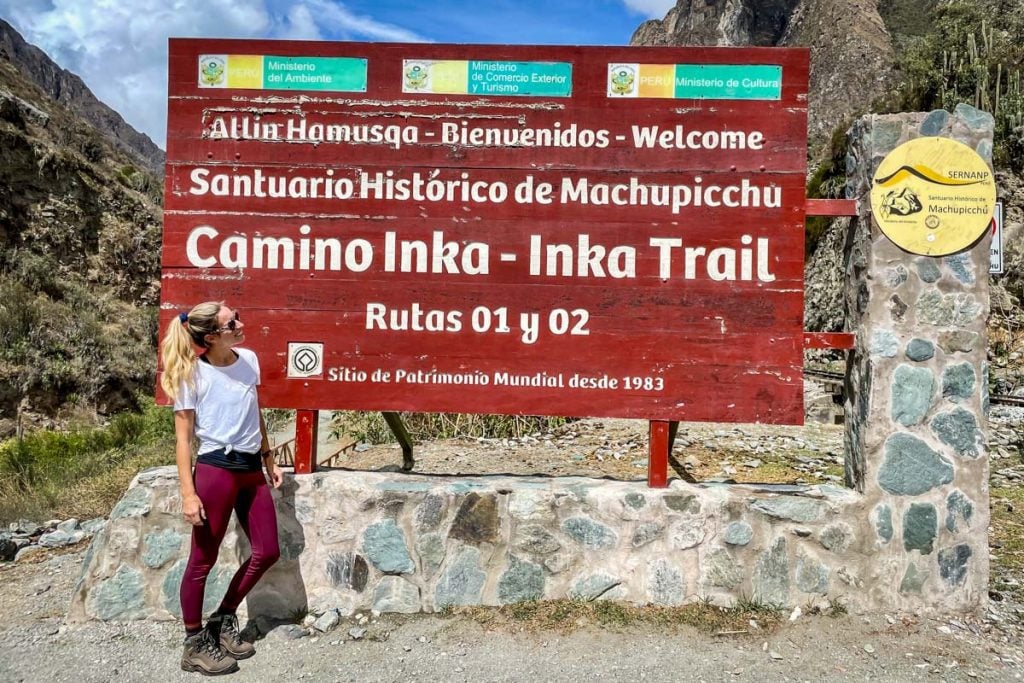
While Peru is a massive country with so many things to see and do, it seems that glimpsing Machu Picchu in the flesh is on just about every traveler’s bucket list. And unlike some tourist attractions it is very much worthy of a spot on your own list.
Seeing these ancient ruins appear as low hanging clouds part and llamas meander past is truly spectacular.
To this day, it is one of the most incredible things I’ve seen.
After my first visit to Machu Picchu, I had one big regret: Not hiking the famous Inca Trail. (The friends I went with weren’t exactly into hiking.)
Lucky for me, I have a husband who has been dreaming of hiking the Inca Trail since he was young, and it’s always been on his South America bucket list, so I got a second go at something that for many is a “once in a lifetime” experience.
Since we’ve had the privilege of visiting Machu Picchu twice in one lifetime, when we were offered an opportunity to visit for a third time, we decided to pass the experience along to our Director of Content, Amanda.
She was just as excited about hiking the Inca Trail to Machu Picchu as we once were. And she wanted to create a super information-packed resource for anyone else who is planning their own Machu Picchu trip.
Amanda will be taking it over from here as she walks you through her experience on the trail and what it was like day-to-day. In this article we’re including everything you need to know about hiking the Inca Trail to Machu Picchu so you can get the most out of your experience (and not have to repeat your trip, like I did!).
Psst! Looking for other ways to visit Machu Picchu that don’t include trekking? We put together a detailed guide on how to get to Machu Picchu on your own that breaks down the complicated ticketing process and other important info.
Inca Trail to Machu Picchu Guide
- Brief history
- When to go
- How to choose a Machu Picchu tour operator
- Save money on your Inca Trail Trek
- Itinerary
- What to pack
- Travel insurance
- What’s included in your trek
- Tipping on your trek
- Responsible travel tips
- FAQs
- Alternative Hikes
Disclosure: This Inca Trail trek was sponsored by Alpaca Expeditions, but all opinions are 100% honest and our own.
A brief history of the Inca Trail & Machu Picchu
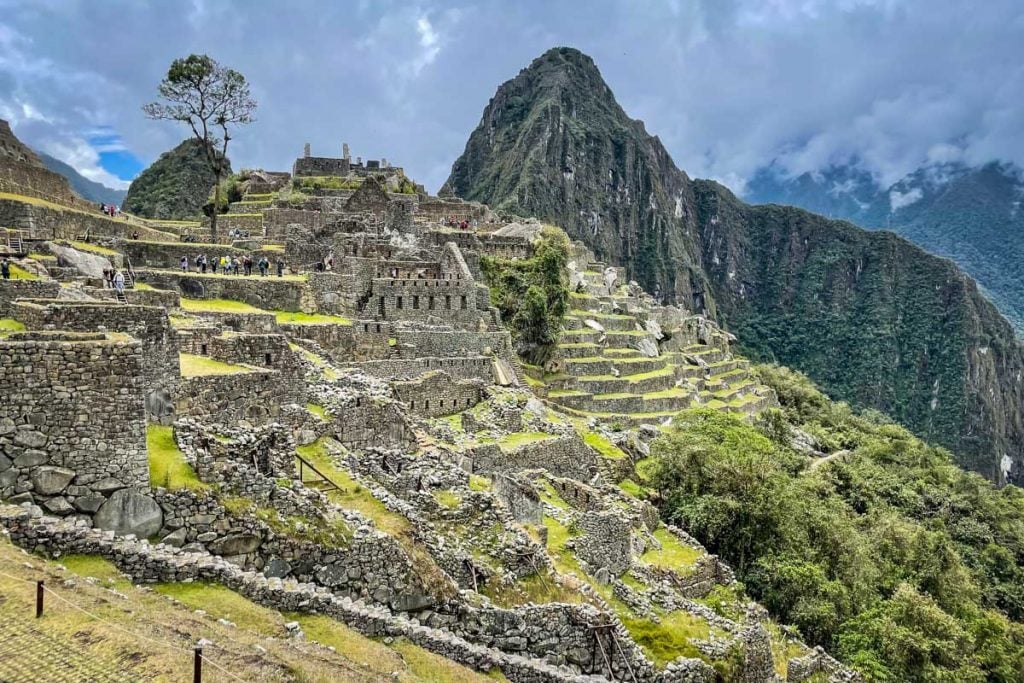
Machu Picchu is believed to have been built by Pachacuti Inca Yupanqui, ruler of the Inca during the mid-1400s at the height of their power. The archeological site sits on the eastern slope of the Andes, high above a loop in the Urubamba river, nearly 8,000 feet (2,430m) above sea level.
The site covers 80,000 acres (32,374 ha) on a plateau with terraced fields on the edge that were once used for growing crops.
Its breath-taking views and well-preserved architecture has earned Machu Picchu the title of one of the Seven New Wonders of the World. Today, it is one of the most-recognized ancient sites in the world.
The Inca Trail to Machu Picchu is just a small part of the vast network of roads built throughout the ancient Inca empire. Known also as the “Royal Road”, this trail was a route used by the emperor in the 15th century to make a pilgrimage to Machu Picchu. Unlike most of the roads built for commercial use, the purpose of the Inca Trail was ceremonial. The pilgrimage included rituals to honor the mountains and peaks of the route.
Modern day concern about overuse of the trail has led to the Peruvian government placing strict regulations on the number of tourists permitted to hike the Inca Trail each year, as well as the companies that are allowed to provide tours. As a result of this, booking your trek well in advance is absolutely mandatory and tours can fill up fast during high season.
Psst! If you’ll be traveling more throughout the country, be sure to check out our bucket list of can’t-miss things to do in Peru!
Best time of year to visit Machu Picchu
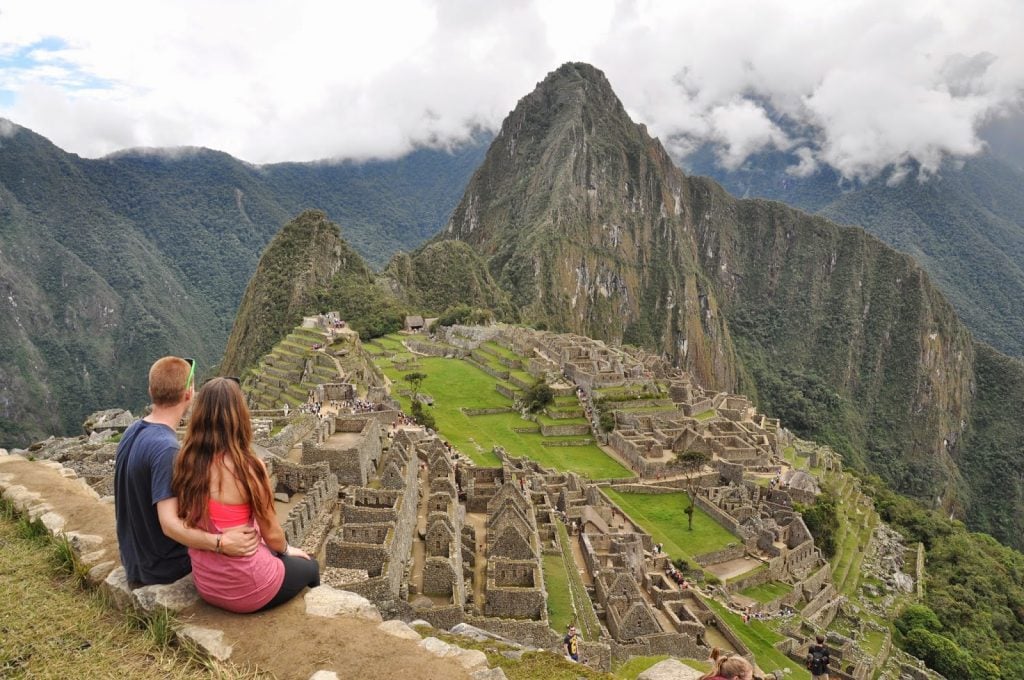
To answer this question, the best way to look at it is to break down the seasons in the region and nearby Cusco, Peru. Keep in mind Peru lies in the southern hemisphere and the seasons are opposite those in the North. We’ve laid out the best times to visit below based on the north-American seasonal calendar.
Winter (November – March) in Cusco is rainy and you may run into mudslides on the trail. It is not advisable to plan a trek during this season. It is also important to note that every February the trail shuts down for cleaning and maintenance, so no bookings will be permitted during this time.
Summer (June – August) is peak tourism season in Cusco with tons of Europeans, Americans and Canadians visiting on their summer holidays. This will be the busiest time at Machu Picchu and a trip during summer is likely to include crowded tours and shuttle buses, plus loads of other tourists in the background of your photos.
However, this is also the dry season in the Andes and you’re most likely to have the best weather on the Inca Trail. If you plan on booking a trek during peak season, we’d recommend requesting your booking over 6 months in advance to lock in your spot.
This leaves Spring and Fall, the shoulder seasons: April through May, and September through October. Outside of the summer holiday, the trail is likely to be significantly less crowded while weather conditions vary, but may still be optimal. May or September would be the optimal time to plan a trek on the Inca Trail to Machu Picchu.
Psst! For an in-depth guide on the regional seasons, weather patterns and other factors, check out our complete guide on the best time to visit Peru.
How to choose a Machu Picchu tour operator
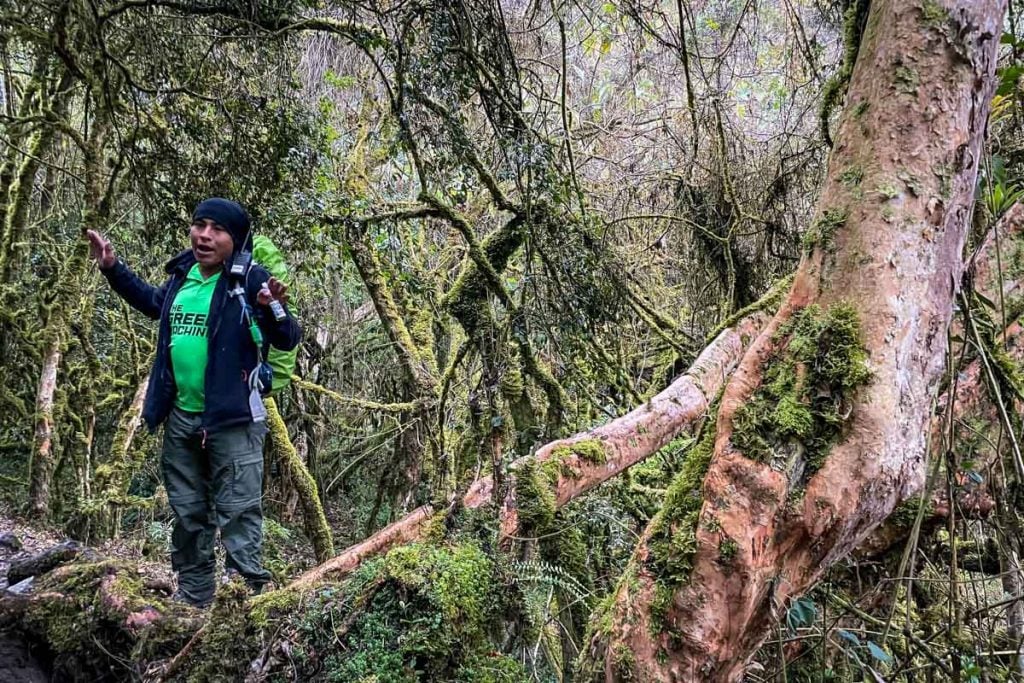
With nearly one million tourists visiting the famous ruins each year, there are seemingly endless tour companies to pick from. So as you can imagine, it can be quite a daunting task to find the best one.
Ranging from minimalist and dirt cheap to over-the-top luxury, you can find Inca Trail tour operators offering just about everything.
One thing that’s really important to us is finding a company that shares our values and promotes responsible tourism practices. For us, this means going with locally-owned over big foreign corporations, employing locals instead of foreigners and paying fair wages, and contributing to the local community in a positive way.
When Alpaca Expeditions reached out to us, we we’re excited to get to know them and did a bit of a deep dive to check them out…
The company prides themselves on being a 100% local-Indiengous Peruvian company who goes above and beyond to treat their employees well.
Raul Ccolque Ccolque, the owner and director of Alpaca Expeditions, was born in the Sacred Valley and grew up speaking Quechua, the Indigenous language of the area. He started his career as a porter, so he knows first-hand how hard they work under strenuous conditions.
With five stars on TripAdvisor and a reasonable price, there’s really no reason not to go with them! Plus, they are known for having some of the best food on the trail and quality equipment that makes for more comfortable camping situations.
Alpaca Expeditions did not disappoint. I was served delicious meals daily, and although I had to wake up before sunrise each day, the guides greeted me with cocoa tea in hand outside my tent. Talk about “room service”!
The thing that we appreciate most about Alpaca Expeditions is they have a reputation for treating their porters right. We always try to travel responsibly, so knowing they have fair business practices was very important for us because not all the tour agencies can say the same.
Here are some things to look out for when researching trekking options:
- Who owns the company? Are they local Peruvians or an International corporation?
- Where do they operate? Do they run tours just in Peru, or all over the world? If they are a major tour company operating all over the globe, will they be tuned into the nuances of running a sustainable and responsible operation on the Inca Trail?
- Are their values listed on their website? We loved that Alpaca Expeditions listed their company goals and values right on their website, so we knew we were in alignment right away.
- How do they treat their employees? Do they mention anything on their website about fair wages? Inclusion? Porter care?
Save money on your Inca Trail Trek
After my exceptional experience hiking the Inca Trail, we’ve partnered with Alpaca Expeditions to pass the savings on to you!
Use our promo code: TWS
Book your Inca Trail tour or any other trek with Alpaca Expeditions using our exclusive promo code and you’ll receive a FREE sleeping air mat and trekking poles rentals with your trek.
Believe me when I tell you, the trekking poles are worth it! Especially for the challenging up and downhill climbs on the second day of the trek. Plus renting a sleeping mat means you won’t have to haul your own all the way to Peru (more room in your suitcase!).
Inca Trail hike itinerary
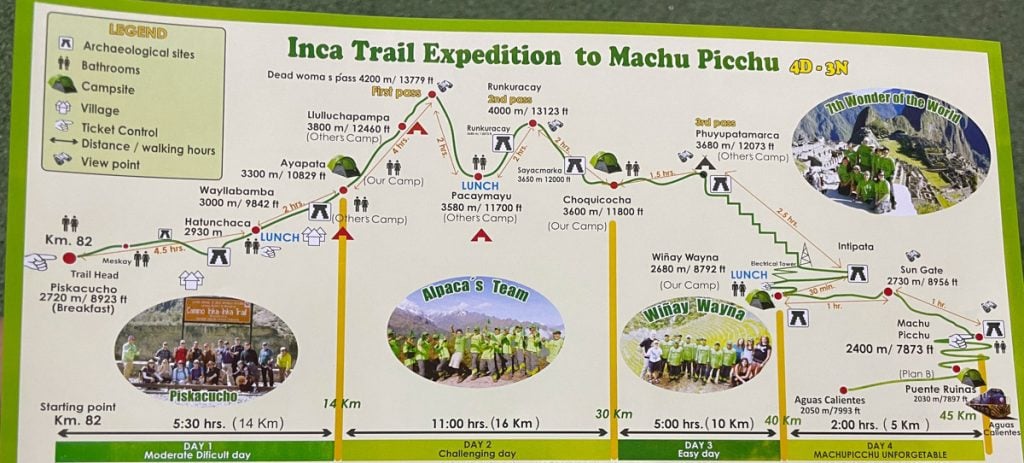
Below is a detailed breakdown of the daily hiking stats and what you can expect each day on the Inca Trail to Machu Picchu.
Day 1: Cusco – Km 82 – Ayapata
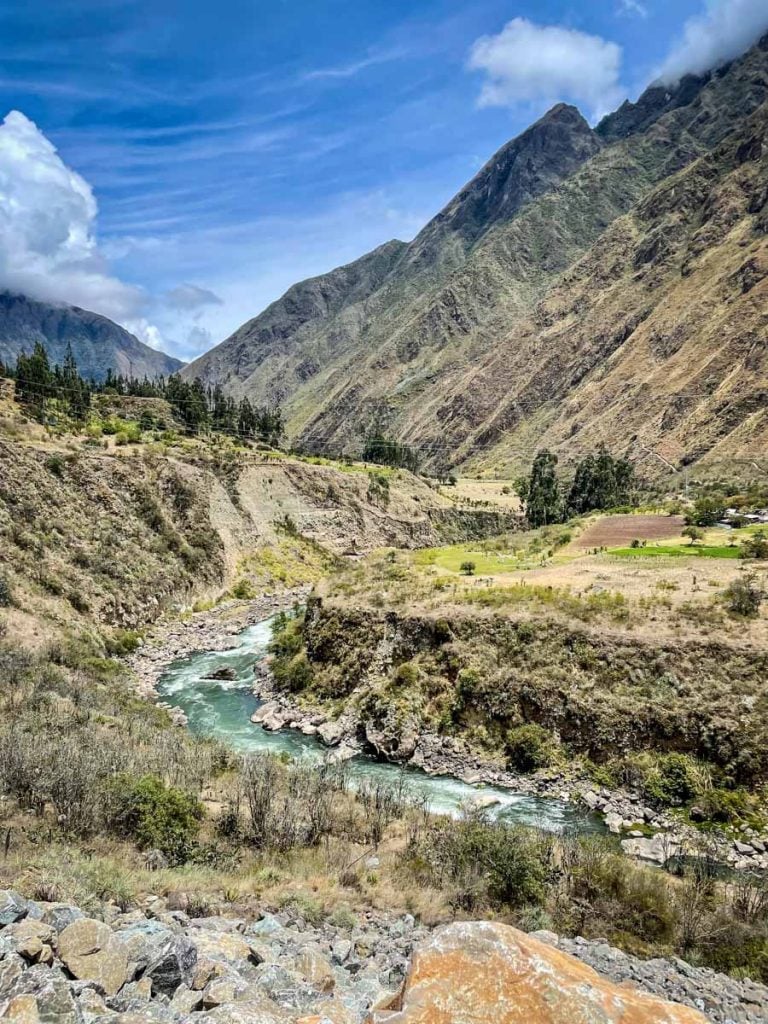
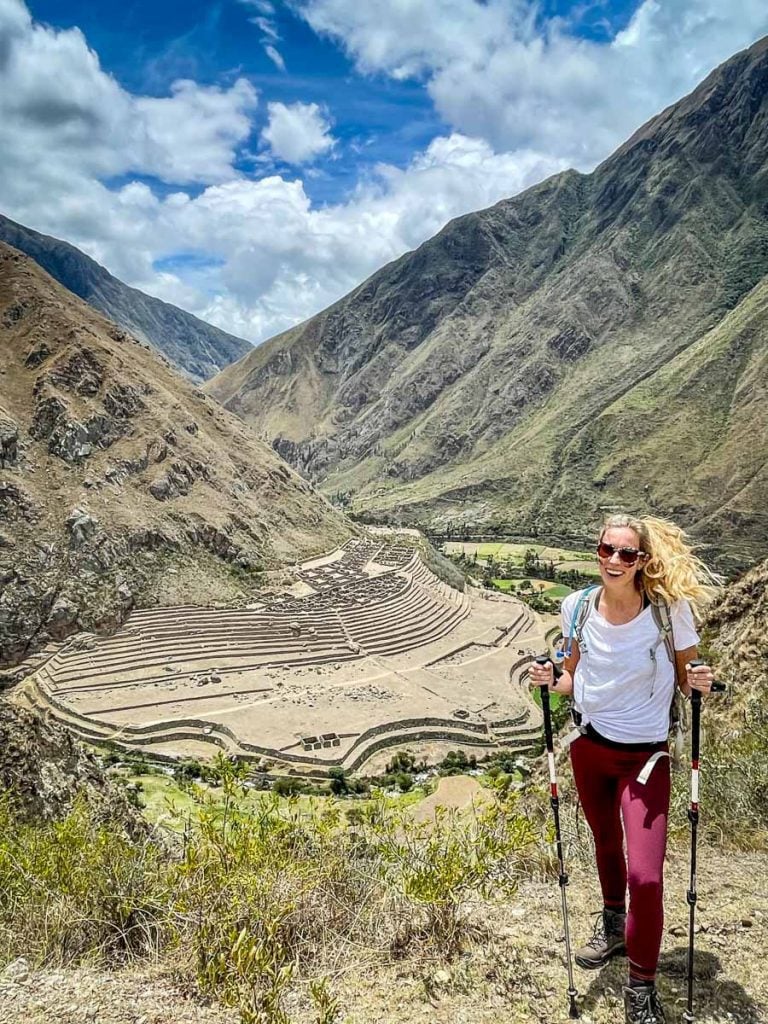
- Distance: 14 km (8.7 miles)
- Elevation gain: 580m (1,906 ft)
- Peak elevation: 3300m (9,842 ft)
- Total trekking time: ~ 5.5 hours
- Difficulty Level: Moderate
Day one of the trek starts with an early morning pick-up from your hotel in Cusco (between 4:00 – 4:30 a.m.). You’ll board a large tour bus (with comfortable seats and AC!) for the 2 hour ride to Km 82, the official start of the Inca Trail, located just outside of Ollantaytambo.
A stop for breakfast will give everyone a chance to wake up and prepare to begin the trek.
After passing through the first checkpoint (you’ll need to show your original passport here!), and a briefing from your guide, you’ll be on your way!
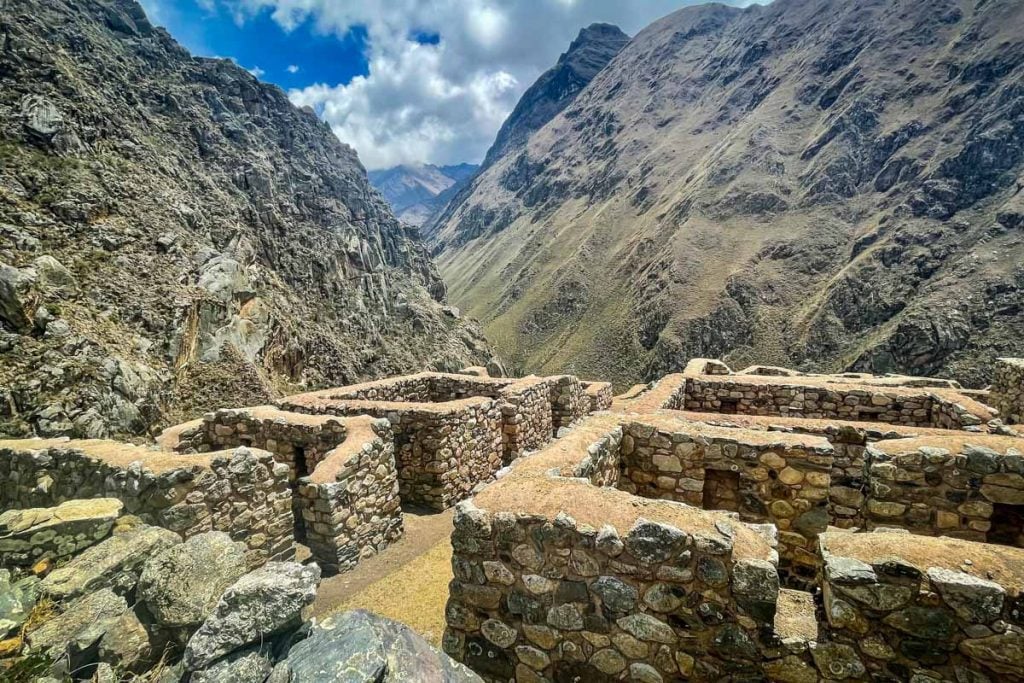
The first 2 hours or so of the trail are relatively flat and easy as you make your way to the first Inca site, Patallacta. There will be small shops to purchase snacks and drinks along the way, so bring some extra soles with you.
From Patallacta, you have another few hours of hiking to get to the lunch spot. Lunch is served family-style inside a tent at a long table. This is a nice time to relax and enjoy some hot food with your fellow hikers.
After lunch, you’ll have another 2 hours or so of hiking left before you arrive at your campsite for the evening. This last bit of the trail has more elevation gain, so it gets tougher as you go. You’ll arrive at camp by about 5:00 p.m. where a “happy hour” of hot tea and snacks will be waiting for you.
Day 2: Ayapata – Dead Woman’s Pass – Runcuraccay Pass – Chaquiccocha
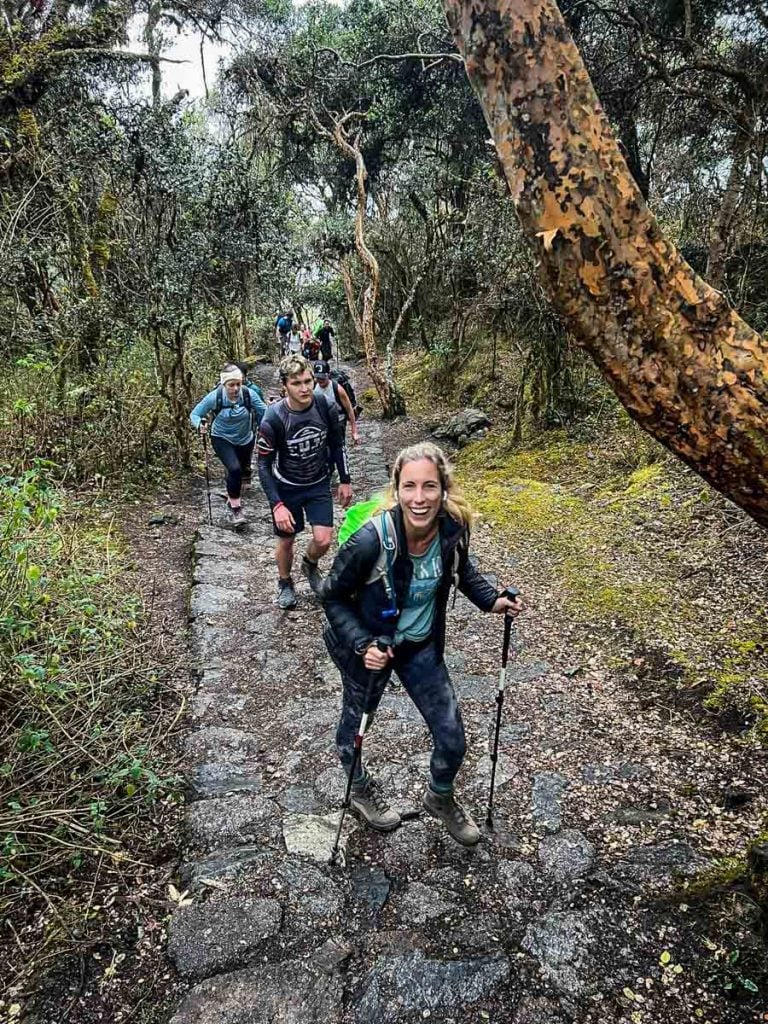
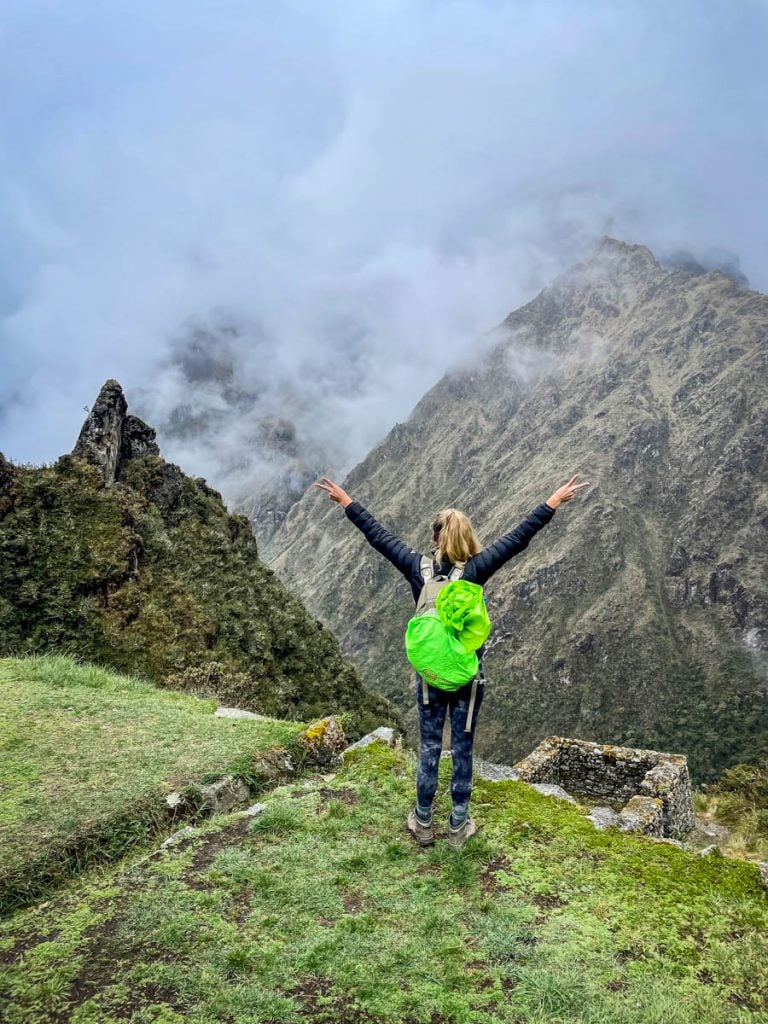
- Distance: 16 km (10 miles)
- Elevation gain: 900m (2,953 ft) / 420m (1,378 ft)
- Peak elevation: 4200m (13,780 ft)
- Total trekking time: ~11 hours
- Difficulty Level: Difficult
The second day is known for being the toughest and the longest, so your guides will wake you up early with a hot cup of cocoa tea in your tent.
Prepare with a hearty breakfast before setting out on the ~4 hour hike to reach the highest pass of the trail – Dead Woman’s Pass.
This section will be completely uphill. Oh, and don’t forget about the altitude. At more than 4,200 meters (13,800 feet) at the peak, I’ll take some effort and a lot of will power, but you’ll make it to the top. Still not as bad as hiking above 5,000 meters on our Everest Base Camp trek.
The landscape along the way was stunning and made up for all the out-of-breath moments.
When I would stop to breathe and readjust my pack – which was a common occurrence – porters would whiz past me. They carried packs four times the size of mine, wore sandals, and some were old enough to be my grandfather. They were incredible.
And made me feel a bit inadequate.
When you finally arrive at Dead Woman’s Pass – the point at which the path starts going downhill – it’ll feel like quite the accomplishment.
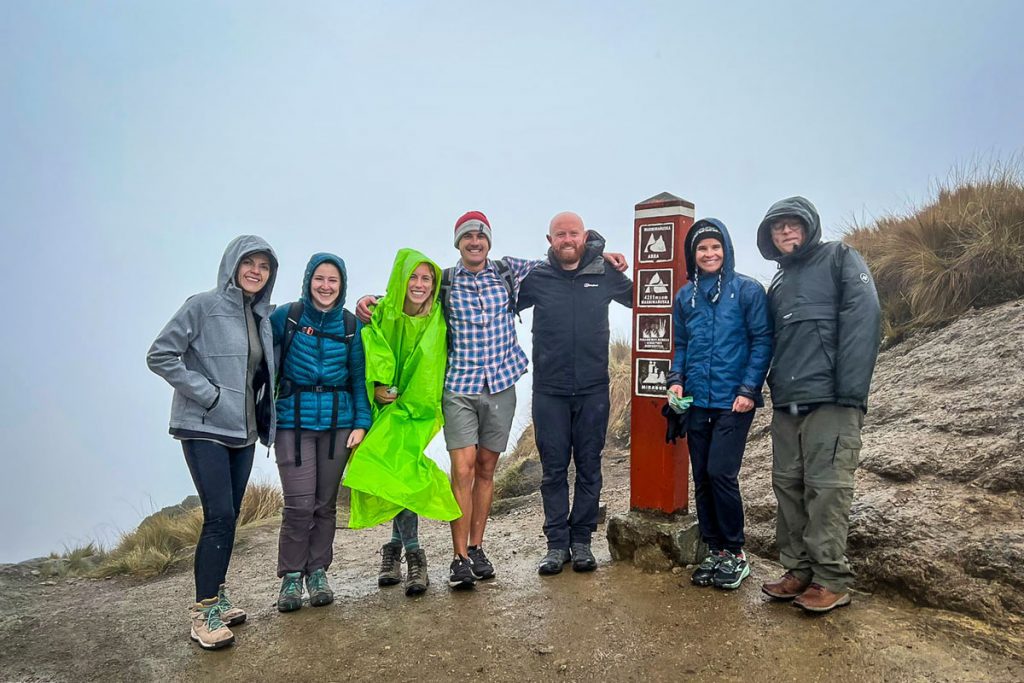
Relax. The hardest part of the trail is behind you now!
You’ll descend for about an hour and a half or so into the Pacaymayu Valley where you’ll stop for lunch.
After lunch you have one more peak to conquer, but it’ll be easier than the last!
A 2 hour ascent will take you to the top of the second pass – Runcuraccay Pass – and you’ll stop at another small Inca site with breath-taking views and two waterfalls cascading down the opposite side of the valley.
On your second descent there will be another Inca site – Sayacmarca (Inaccessible Village) – before you reach your campsite for the night at Chaquicocha. Camping this high in elevation (3,600m) will be chilly, so be prepared with warm clothing!
Day 3: Chaquiccocha – Wiñay Wayna Camp
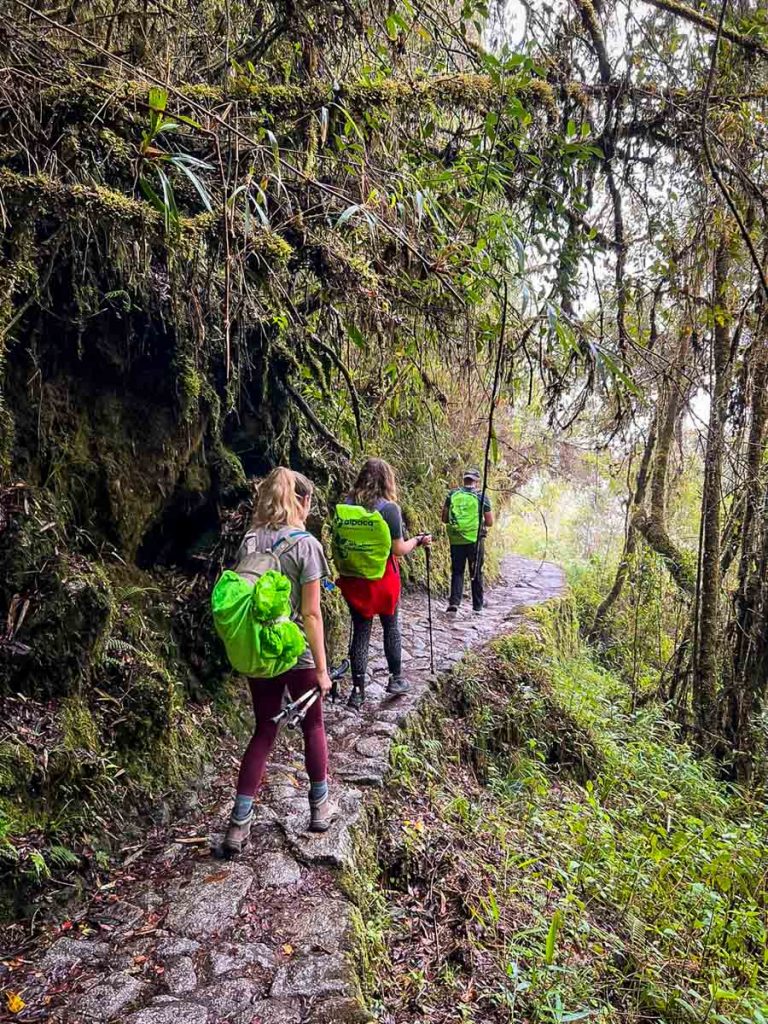
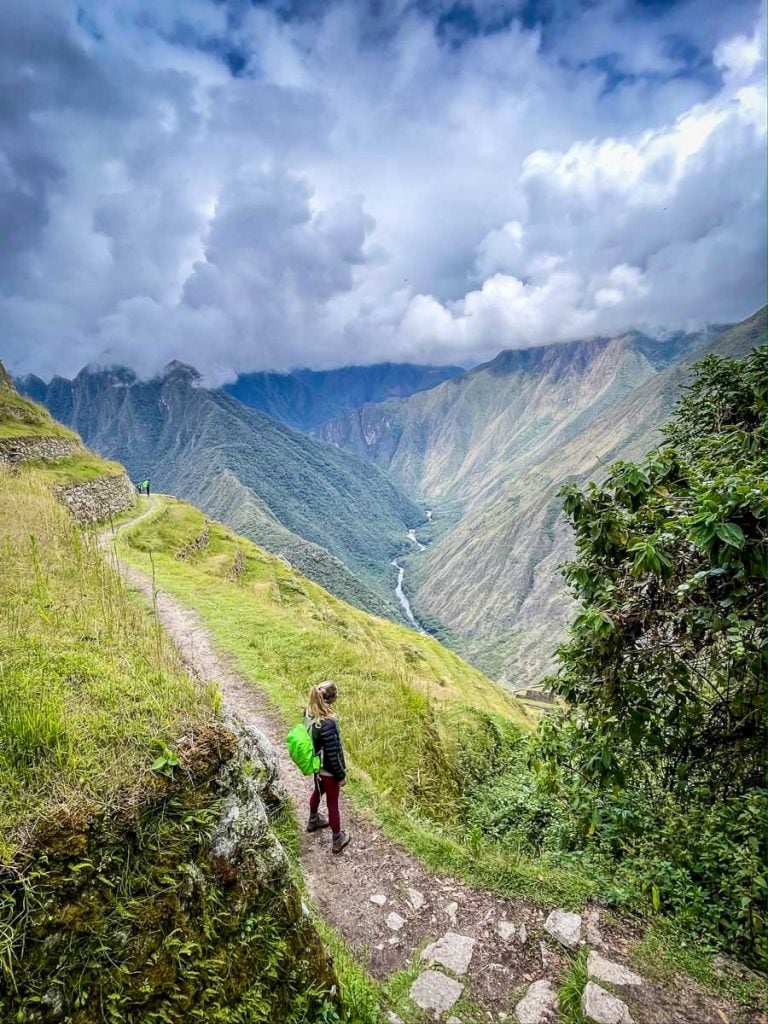
- Distance: 10 km (6.2 miles)
- Elevation loss: 1,000m (3,281 ft)
- Peak elevation: 3,680m (12,073 ft)
- Total trekking time: ~5 hours
- Difficulty Level: Easy
The third day is your easy day— it’s all downhill from here!
This is commonly believed to be the most beautiful day on the Inca Trail so you’ll want to take it all in as you descend into your final valley of the trek.
For the first 2 hours of the hike, you’ll make your way along the “Inca flat” (gradual incline), entering into the peak of the jungle, known as the Cloud Forest. As you gaze down into the valley, you’ll have your first views of Machu Picchu Mountain, but the site will remain hidden from view.
From the final peak – Phuyupatamarka – it’s 3 hours of downhill trekking to reach the lunch stop, which also happens to be where you’ll be camping for the night (yay, short day!).
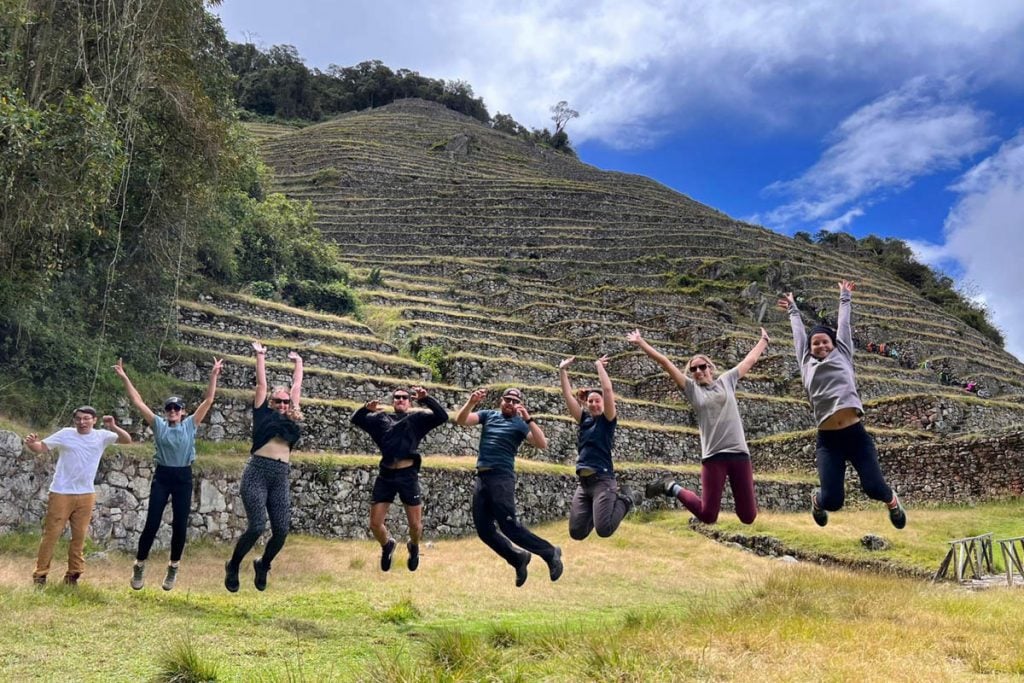
During the descent you’ll stop at 2 more Inca Ruins, Phuyupatamarka (The Town in the Clouds) and Intipata (Terraces of the Sun). You’ll arrive at your campsite around 1:00 p.m. in time for lunch and then have the rest of the afternoon to relax.
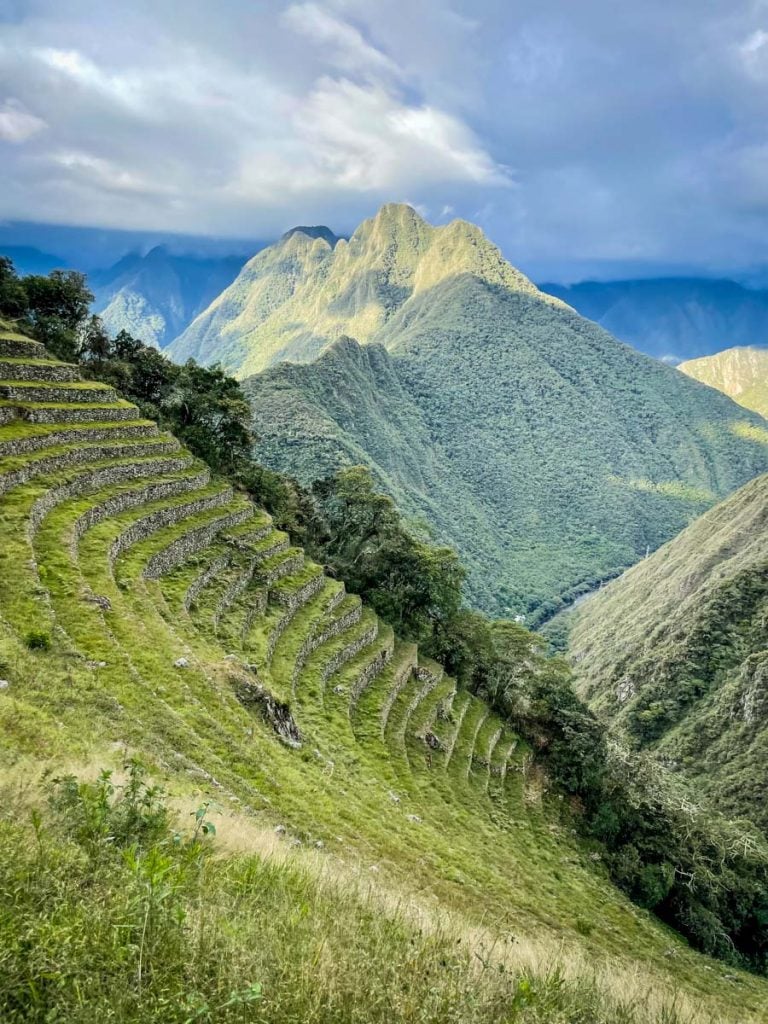
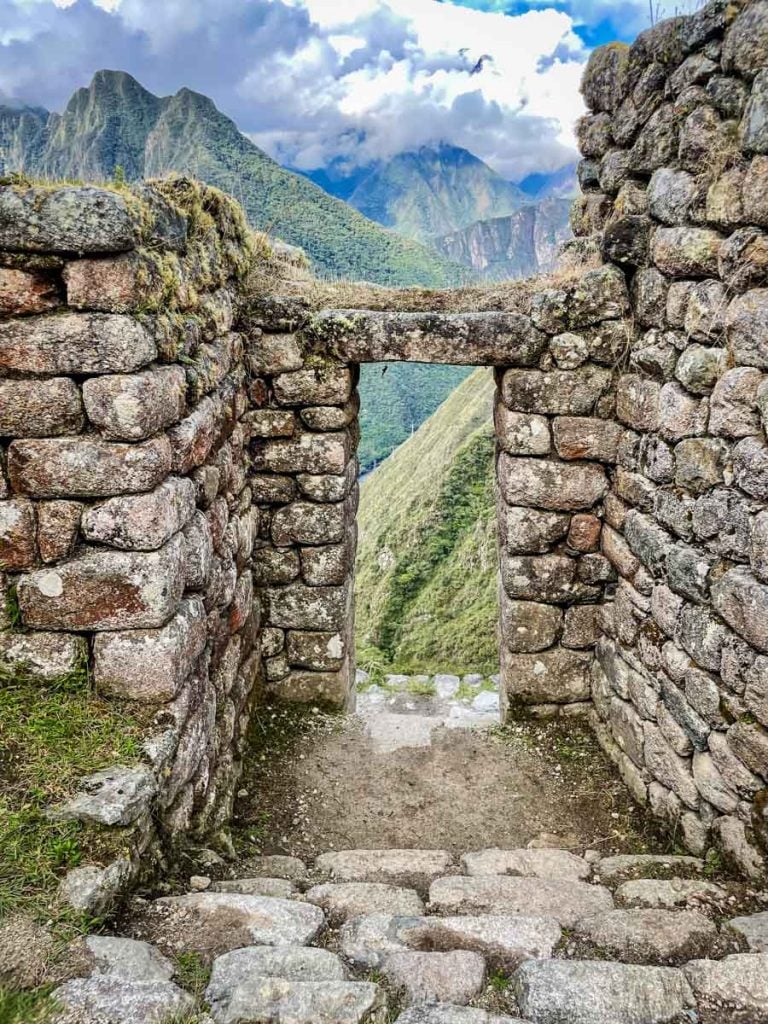
Later in the afternoon, you’ll have the opportunity to visit Wiñay Wayna (just a 10 minute walk from camp – no daypacks or trekking poles needed!), the most impressive Inca site on the trail after Machu Picchu itself.
Day 4: Wiñay Wayna – Sun Gate – Machu Picchu – Cusco

- Distance: 5 km (3.1 miles)
- Elevation gain: 50m (164 ft)
- Peak elevation: 2,730m (8,957 ft)
- Total trekking time: ~2 hours + walking around Machu Picchu
- Difficulty Level: Easy
The final day of your Inca Trail trek comes with the earliest wake up call of all… 3:15 a.m. (cue the Home Alone shocked face!).
The extra-early morning wake up is so the porters can pack everything up and make it to the train on time. We learned local workers (aka porters) can only ride the train to and from Machu Picchu on the first trip of the morning – around 5:30 a.m. and the 6 p.m. train in the evening. If they miss the first train, they have to wait in Aguas Calientes all day before they are able to return to their families.
So pack up early and walk the 10 minutes or so from your camp to the final checkpoint. You’ll be waiting here for a few hours before they open the gate at 5:30 a.m. but at least you’ll be the first ones through!
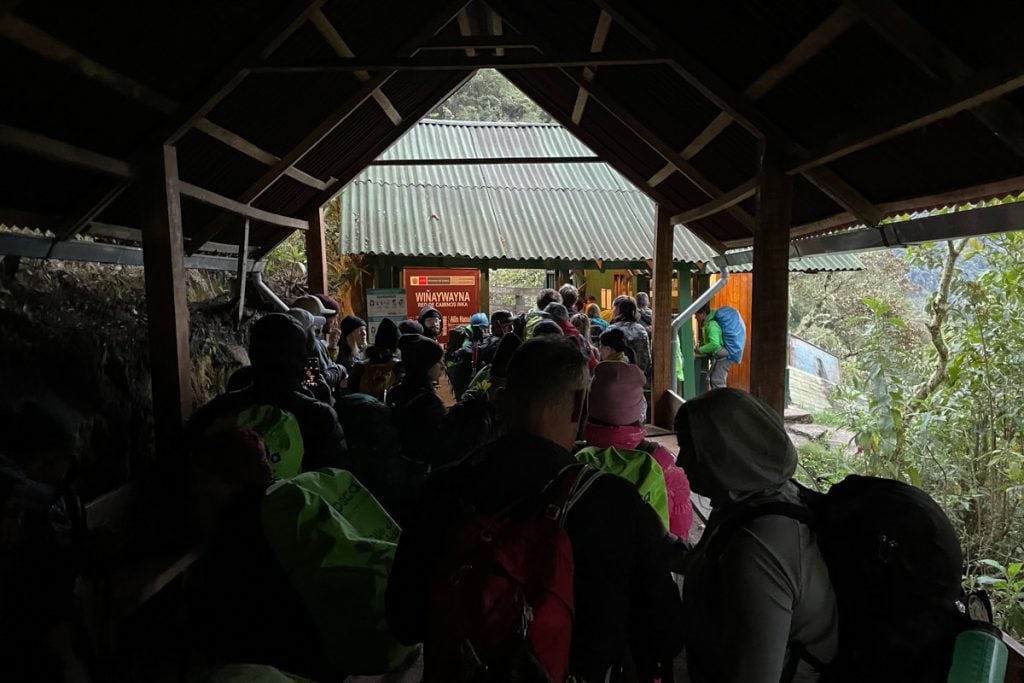
After waving goodbye to your porters and chef, it’s time to make the ~1 hour journey to the Sun Gate (Inti Punku). Weather permitting, you’ll have spectacular views of Machu Picchu from above. (I wouldn’t know – the weather was not cooperating on my final morning of the trek.)
After this it’s only another hour or so to reach the famous Machu Picchu viewpoint (you know, the one you see in all the Instagram photos).
When we reached the grounds, the fog was hanging so thick and low that you couldn’t see more than just a couple meters ahead. Needless to say, when we took a group picture at the famous viewpoint, it looked more like we were inside a cloud than at the famous Inca ruins.
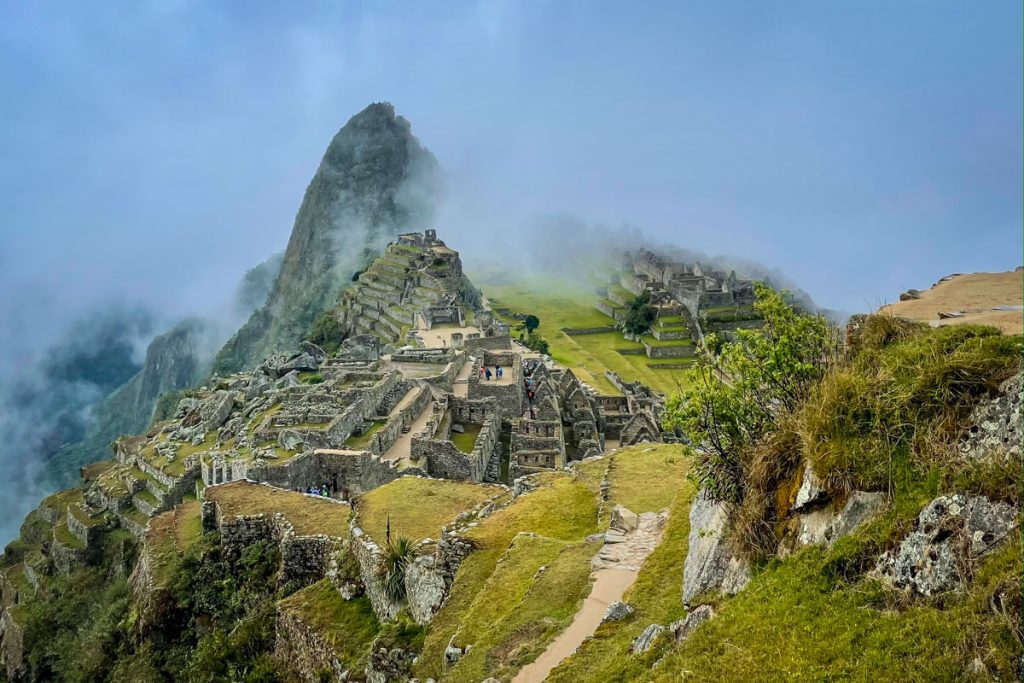
Soon after though, the fog began to lift, and Machu Picchu began to emerge from the mist in all its glory.
It was an unforgettable sight. And since we were there early, the only people at the site were people who had just completed a trek. There was a certain camaraderie amongst us.
Before long though, people started arriving in all directions. Large packs of middle-aged foreigners wearing wide-brimmed hats and carrying massive cameras swarmed around tour guides reciting the history of the ruins in just about every language.
Machu Picchu is listed as one of the 7 New Wonders of the World and is on countless lists of places to see before you die – deservingly so. You can’t, however, deny the shift in atmosphere from peaceful during the early morning hours, to crowded and buzzing with people as morning slips away.
People. Were. Everywhere.
After touring the grounds for about 2 hours with our trekking group and guides, it was time to say goodbye to Machu Picchu and head back to Cusco.
The journey back included a bus to Aguas Calientes, where we stopped for one last meal with our trekking group, and then boarded the train to Ollantaytambo. The Scenic train journey was peaceful and relaxing—a nice place to reflect on the awe of the past 4 days.
Once in Ollantaytambo, we boarded our tour bus for the 2 hour ride back to Cusco and we dropped off individually at each of our accommodations by around 8:00 p.m.
What to pack for hiking the Inca Trail to Machu Picchu
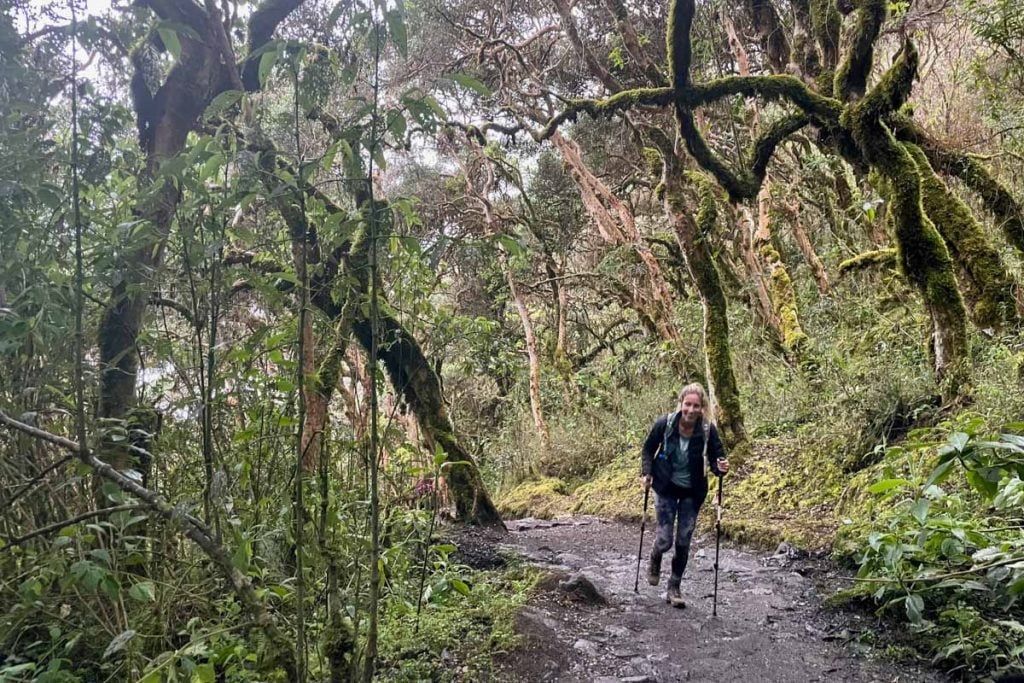
Each tour company is different, but for Alpaca Expeditions we were given a duffle bag to fill with our clothes and overnight necessities, so we only carried our daypacks with us during the day.
By law, porters on the Inca Trail can only carry 25 kg (55 lbs.) in total in their packs (and they do have checkpoints where they will get weighed). Alpaca Expeditions limits their porter’s packs to just 20 kg (44 lbs.) as they feel this is more manageable.
This means there is a strict weight limit on how much you can pack in your overnight duffle.
The limit is 7 kg (15 lbs.) for your duffle. If you are renting a sleeping bag and air mat from Alpaca Expeditions, those weigh a combined 3 kg, so you only have 4 kg for your personal stuff. It’s very important you stick to this weight limit.
Your hotel or hostel in Cusco will have a scale you can use to be sure your pack is within the limit.
Below is a list of all the items I packed to take on my Inca Trail trek.
Hiking clothes
- Hiking boots: It’s not recommended to do this trail in sneakers. I was so glad I had quality hiking boots, especially on the days when it got rainy and the rocks were slippery. (I have these boots and love them!)
- Trekking poles: You can rent these from Alpaca Expeditions
- Comfortable hiking clothes (lots of layers!)
- Bring enough base layers for 4 days, the outer layers and pants can be reworn day after day.
Day pack
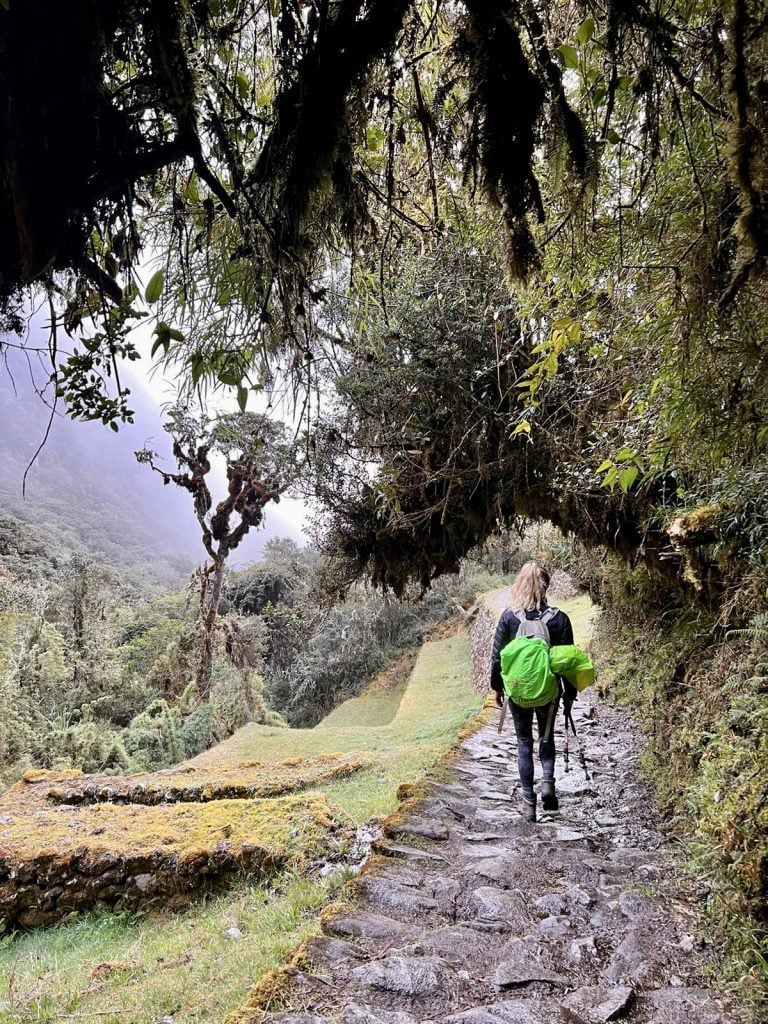
- Backpack: you’ll want to be sure you have a decent daypack for hiking
- Note: You cannot take a pack more than 20 liters inside Machu Picchu, so be sure your day pack is not above the limit.
- Passport: you need to show your original passport on day 1 to enter the trail and again on day 4 to enter Machu Picchu
- Hydration pack: The best way to stay hydrated on the trail is with a hydration pack (we recommend this one with built-in water filtration), if you don’t want to use one of these, be sure to bring a water bottle that holds a minimum of 2 liters.
- Optional: Electrolyte supplements
- Sun protection: sunscreen, sunglasses and hat (optional)
- Insect repellant (we prefer the natural stuff)
- Camera or cell phone
- Note: “Professional” photography equipment including videography equipment and dones are prohibited inside Machu Picchu.
- Portable battery pack: This will come in handy as there is no place to plug in your electronics on the trail (a solar powered power bank would also be a great idea!)
- Hand sanitizer
- Rain gear: Alpaca Expeditions provides plastic ponchos and water-resistance day pack covers, but it’s a good idea to bring a packable rain jacket as well
- Hiking snacks: Alpaca Expeditions provides some snacks each day, but I was glad I brought some protein bars along as well.
- Cash: For tipping (more on that below!), buying snacks on the first and last days, etc.
Duffle
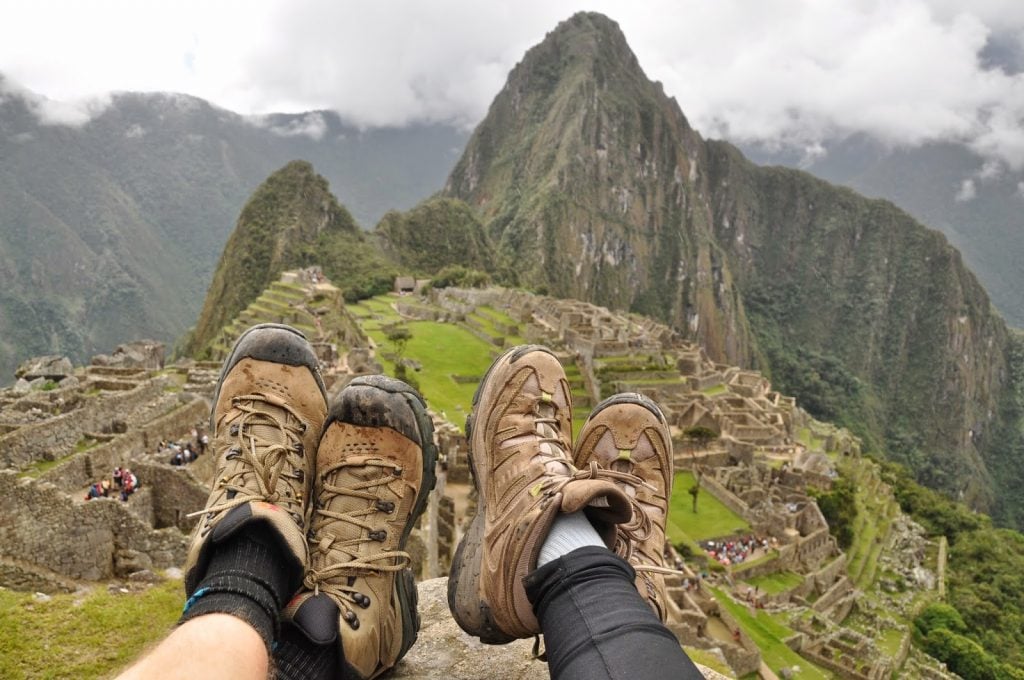
- Sleeping bag (can be rented from Alpaca Expeditions)
- Air mat (can be rented from Alpaca Expeditions)
- Pillow (this is provided by Alpaca Expeditions)
- Sandals or sneakers you can easily slip on and wear around camp
- Sweater or hoodie
- Thermals: for sleeping in
- Packable down jacket
- Hat
- Gloves
- Buff or scarf
- Wool hiking socks (Darn Tough and Smartwool are my favorites!)
- Underwear (4 days worth)
- Headlamp: This is necessary for getting around camp in the dark and on day 4 when you start trekking well-before sunrise.
- Toiletries: Keep it simple! You will receive a bucket of warm water and soap at your tent each evening to clean yourself with, in whatever way you can manage.
- Toothbrush
- Toothpaste
- Deodorant
- Facial / body wipes
- Optional: moisturizer, dry shampoo, hair brush
- Toilet paper: Bring enough for the full 4 days
- Plastic baggy: To dispose of and carry your waste (you can empty your garbage at the camps each night)
- Quick-dry travel towel: To wash your face in the evenings. There are also cold showers available at the camp on the 3rd night.
- Personal medical/first aid kit: Bring any medicines you typically take, plus basics like Ibuprofen, Pepto-Bismol, and Dramamine. You’ll also want some basic first aid supplies like blister bandaids.
- Swimwear (optional): If you are staying an extra night in Aguas Calientes after your trek, you may want to visit the hot springs there.
Don’t forget about travel insurance!
If you’ve been following us for a while, you’ll know by now why we never travel without travel insurance!
Most standard travel insurance policies will cover hiking and trekking up to a certain altitude (usually anywhere from 2,000 – 6,000 meters). The maximum altitude reached on the Inca Trail hike is 4,200 meters. Double-check your policy’s altitude limits to figure out if you’ll need to purchase a separate plan for high altitude coverage.
We saw far too many people get helicoptered off the trail on our Everest Base Camp trek because they got sick from the elevation. While this wasn’t the case when we trekked the Inca Trail, we always say to aire on the side of caution.
We purchased a policy from World Nomads, in which high altitude trekking coverage comes standard. We were at ease knowing that if anything happened, we were insured.
(This also comes in handy if you plan to hike to Rainbow Mountain during your time in Peru!)
What’s included in your trek
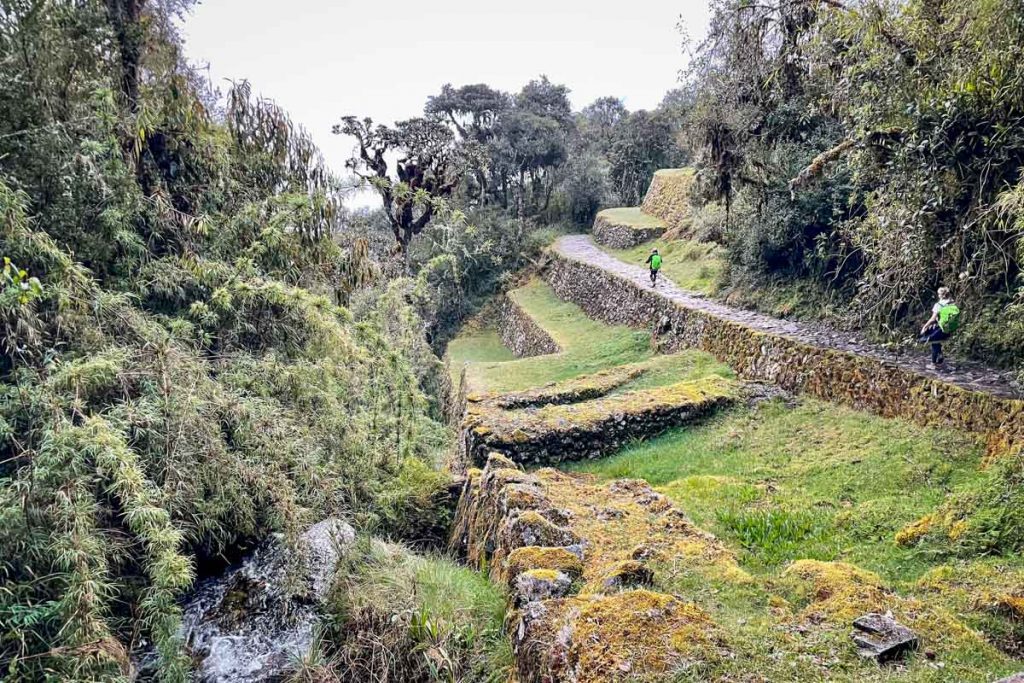
The following is included in the full cost of your Classic Inca Trail trek.
- Pick up from your accommodation in Cusco
- Transfer to the start of your trek at Km 82
- Professional English speaking tour guide
- Entrance fee to the Inca Trail National Park
- Entrance Fee to Machu Picchu
- Porters to carry all equipment, tents, food, and cooking and dining supplies
- Porters to carry your personal belongings, up to 7 kg
- Permits and entrance fees for the porters and chef
- All meals including: 4 breakfasts, 4 snacks, 3 lunches, 3 “happy hours” and 3 dinners, all prepared by a professional chef
- Specialized diets on request
- Pillows
- Cocoa tea served each morning in your tent
- Boiled water for drinking and filling your bottles/packs
- Note: You will need to bring your own water on the first day to tide you over until lunchtime!
- An oxygen tank and first aid kit
- Personal tents for 2 person occupancy
- If you are traveling solo, you will be placed with another trekker of the same gender, or have the option to pay an extra fee for a single tent.
- Dining tents for each meal
- Private portable toilet tent, only to be used by your trekking group
- 2 hour guided tour of Machu Picchu
- Optional: to request hiking one of the mountains inside Machu Picchu, you will need to request and book (costs extra) in advance.
- Bus from Machu Picchu down to Aguas Calientes village
- Expedition train from Aguas Calientes to Ollantaytambo
- Transfer to Cusco and drop-off at your accommodation
Not included in the cost of your trek
- Lunch on the 4th day in Aguas Calientes: it is customary for the group to eat one final meal together. This meal will be al la carte and paid for individually.
Rental costs
- Sleeping bag: $20 USD
- Inflatable sleeping pad (air mat): $15 USD
- Trekking poles: $15 USD (pair)
Psst! Use our special discount code when you book your trek with Alpaca Expeditions to receive a FREE sleeping air mat and trekking poles rentals!
Use our promo code: TWS
Tipping on your Inca Trail trek
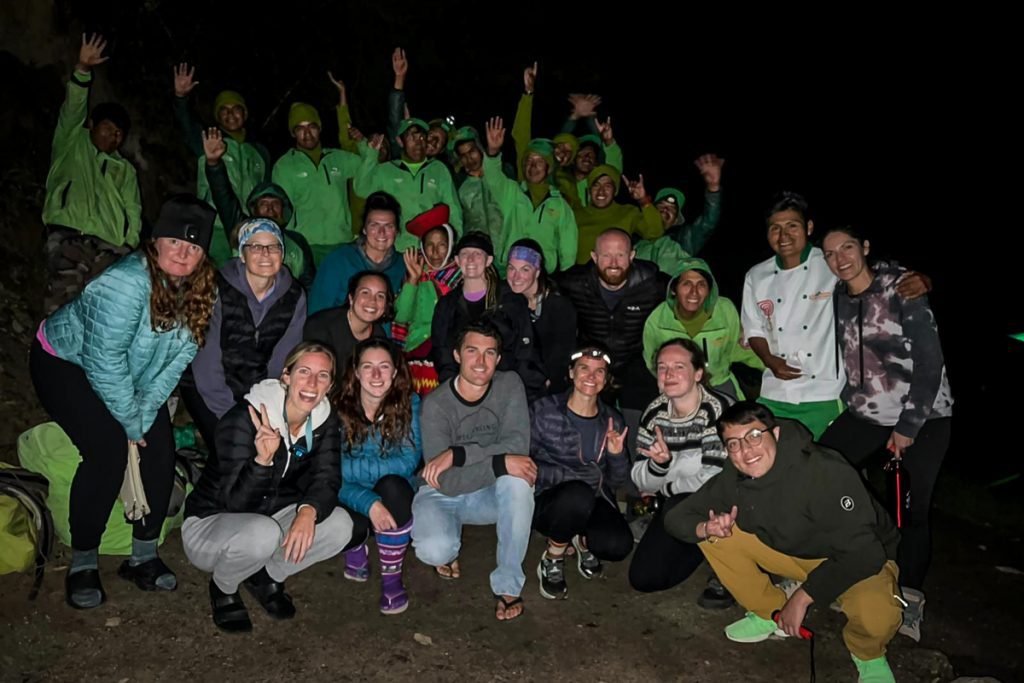
Tipping is of course 100% voluntary, but as an accepted practice on the Inca Trail (and alternative treks) it can be a bit confusing to know exactly what is appropriate. Below are some general guidelines to help you navigate this custom.
If you choose to tip, there are 3 main pools you will need to consider:
Porters
These are the hard working individuals who are carrying not only your stuff, but everything needed to set up camp and prepare your food on the trail.
As we mentioned above, Alpaca Expeditions pays their porters fair wages so they are not relying on tips to survive. However, tipping your poters is a nice gesture to show your appreciation for the hard work they put in to make your trek possible.
Typically the trekkers pool their tips together and offer the porters one large sum to be divided evenly amongst themselves. This is done on the 3rd and final night after dinner.
A customary tip for each porter is to receive between 80-100 soles for the trek.
Find out how many porters are on your trek, multiply that by the amount you think they deserve, then divide that total by the number of trekkers in your group to see about how much each person should contribute to the pool of tips on average.
Tipping Formula: (X x Y ) / Z = average amount each person should contribute in tips
- X = number of porters on your trek
- Y = amount in soles (between 80-100)
- Z = number of trekkers in your group
Chef
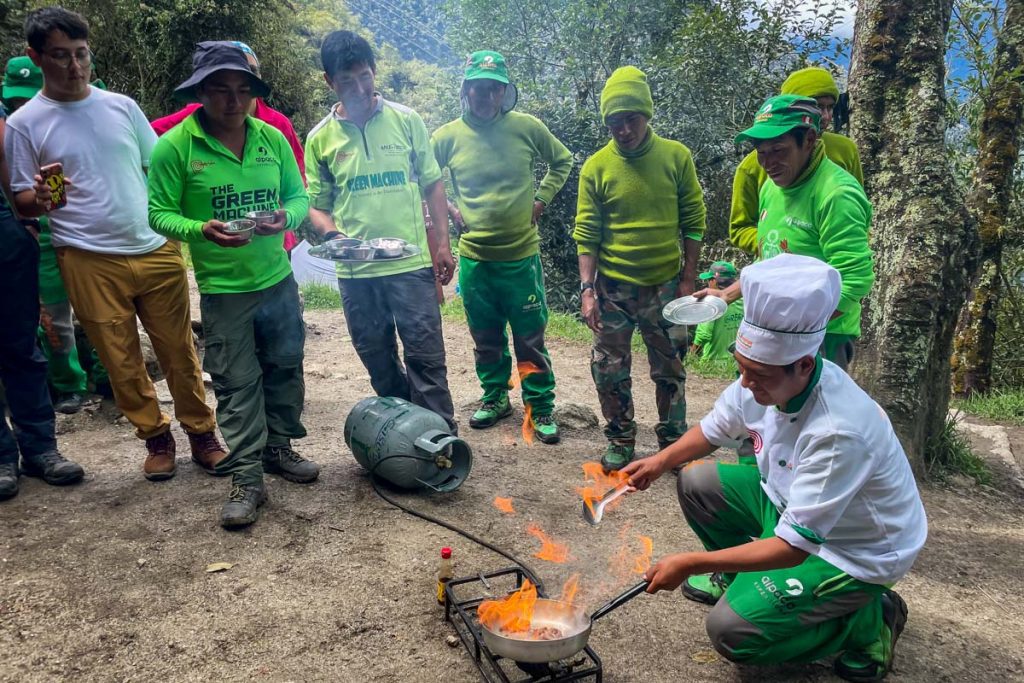
Each trek with Alpaca Expeditions will have a professional chef who is responsible for preparing all of the delicious meals you’ll enjoy on the trail. These guys work some kind of magic cooking at high altitude with limited equipment outdoors!
I am told it is customary for the chef to receive about double what the porters get. So if each of your porters were to receive 100 soles, your chef should receive 200 soles.
Take 200 soles, divide that by the number of trekkers in your group, and that’s how much (on average) each person should contribute to the chef’s tip pool.
Tipping Formula: Y / Z = average amount each person should contribute in tips
- Y = amount in soles (between 160-200)
- Z = number of trekkers in your group
Again, this is typically gathered on the 3rd and final night of the trek after dinner.
Guides
Your guides are the ones who will be leading you through the entire trek from the briefing on the first night all the way up until you’re dropped off back at your accommodation in Cusco on the last day.
These guys will be with you every step of the way… literally. They have a wealth of knowledge to share with you about the trail and the ancient Inca customs and sites along the way.
Tipping your guides is done on an individual basis (no pooling tips) and is entirely up to your discretion.
I am told it is customary for each guide to receive a tip between 100-160 soles from each trekker for their time with you on the Inca Trail. Again, this is completely up to you and what you feel comfortable giving. If tipping 50 soles is more within your means, that is perfectly acceptable. And if you do not feel your guide deserves a tip, that is your decision to make.
Responsible travel tips for the Inca Trail and Machu Picchu
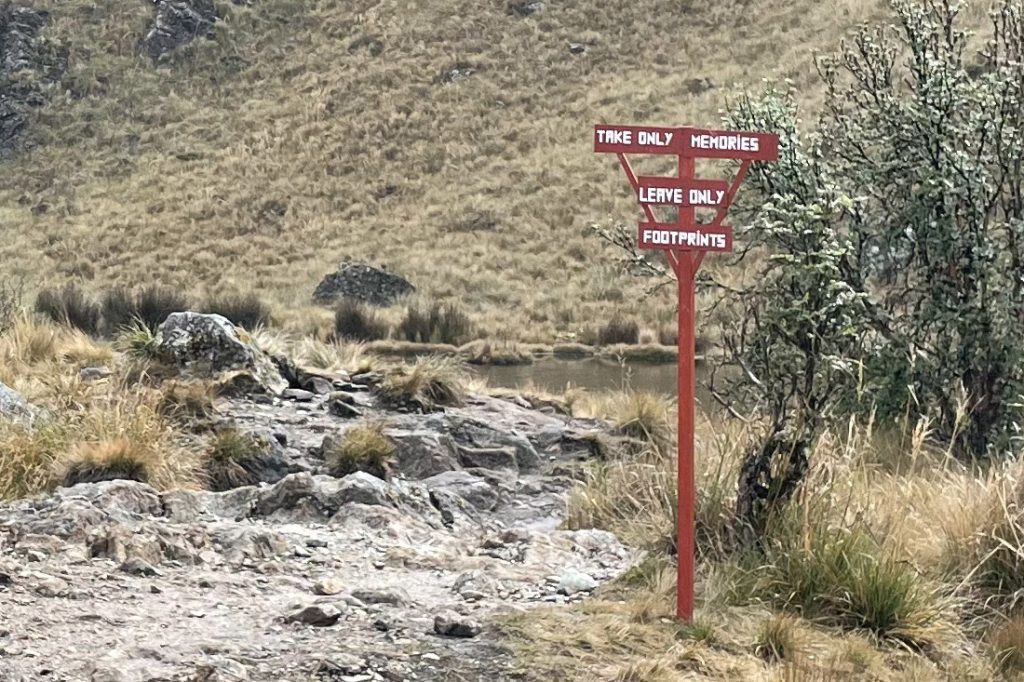
The popularity of Machu Picchu as a destination for tourism is undeniable—it has been the most visited attraction in Peru for decades and a huge driver of the tourism economy in the country.
However, that attention comes with consequences. Machu Picchu has fallen victim to overtourism and in 2008 was added to the World Monuments Fund’s Watch List of 100 Most Endangered Sites, due to environmental degradation from unsustainable visitor numbers.
Luckily the Peruvian government has stepped up to put some regulations in place and limit the number of daily visitors to 2,500 per day. Daily visitors are now limited to specific time slots and ticketed routes through the citadel.
You can read more about the Machu Picchu entry tickets and regulations in our article on how to get to Machu Picchu.
There are limited permits available for the Inca Trail as well—just 500 per day. And more regulations around what you can and cannot bring (such as no plastic water bottles, and trekking poles must have rubber tips).
We’ve put together a list of responsible travel tips for hiking the Inca Trail to Machu Picchu.
1. Leave no trace
This should go without saying, but anytime you are in nature, including hiking the Inca Trail, you should always follow the 7 principles of Leave No Trace.
Of particular importance on the trail is #3: dispose of waste properly. You should pack out any and all waste you create while hiking the Inca Trail. It’s a good idea to carry a plastic baggy with you where you can store your garbage for the day (including used toilet paper!) and dispose of it properly in waste receptacles in the evenings.
2. Stay on the trail
The ecosystem surrounding the Inca Trail is a delicate one.
Trails are designed not only as a literal guide for people to follow, but also as a critical way to protect the area. It’s important to consider how our footsteps can impact fragile vegetation on the Earth’s surface.
Stepping off the trail, climbing trees, swinging from branches or picking flowers can damage that ecosystem in irreparable ways.
Remember it is a privilege that we are able to traverse this ancient path and follow in the footsteps of the Incas. Treat it as if you were a guest in someone else’s home and respect their space.
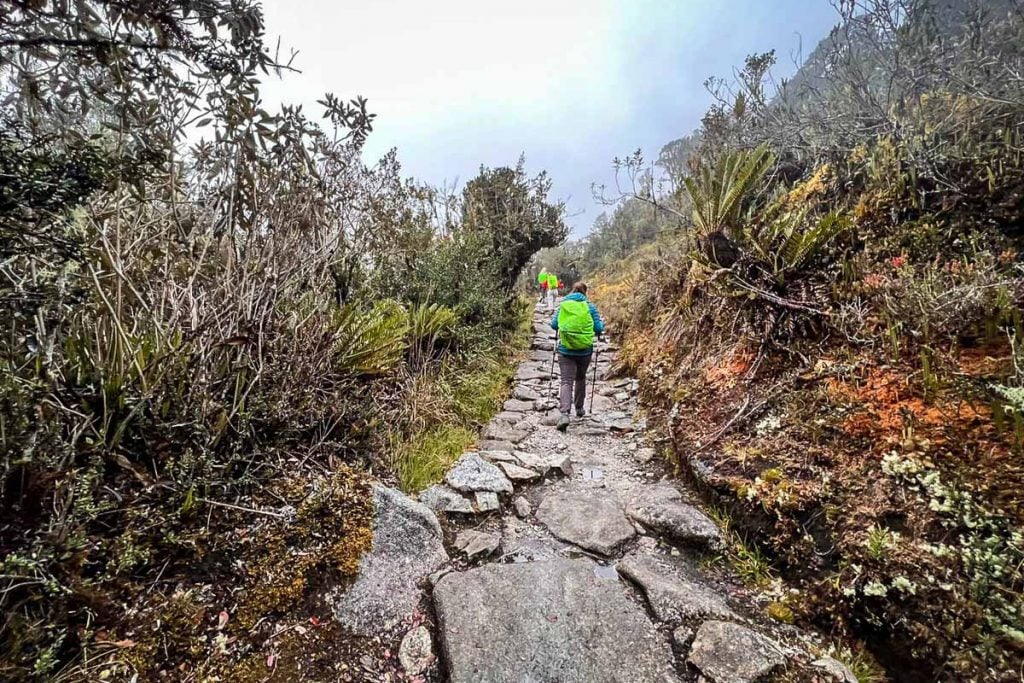
3. Do not liter, not even organic food waste
Many people carry the false belief that if it’s organic and came from the earth, it’s not literally to toss it into a bush. Wrong.
While organic, food waste can still take years to break down and is not part of the natural biodiversity of the area. Discarding food waste on the trail is the same as expecting your waste to become someone else’s problem. And that’s not cool.
As with all other waste you accumulate on the trail, pack food scraps such as apple cores and orange peels away with you until you find a proper disposal container.
4. Follow the rules
Pay attention and respect signs along the trail. When it says, “Don’t climb” – DON’T CLIMB. When it says, “Don’t take photos” – DON’T TAKE PHOTOS.
It’s simple, but many tourists overlook this.
Oftentimes these signs are in place for a good reason: to reduce erosion, to protect a holy site for future generations, or even to keep people safe. Respect these rules.
5. Respect the ruins
There will be many opportunities to get up close and personal with Inca ruins as you traverse the Inca Trail. It may be tempting to lean on or climb the walls to get a better photo or vantage point. However, this is prohibited. As is vandalizing or even touching the stones in any way.
For more ideas, check out our Responsible Travel Tips article.
Inca Trail FAQs
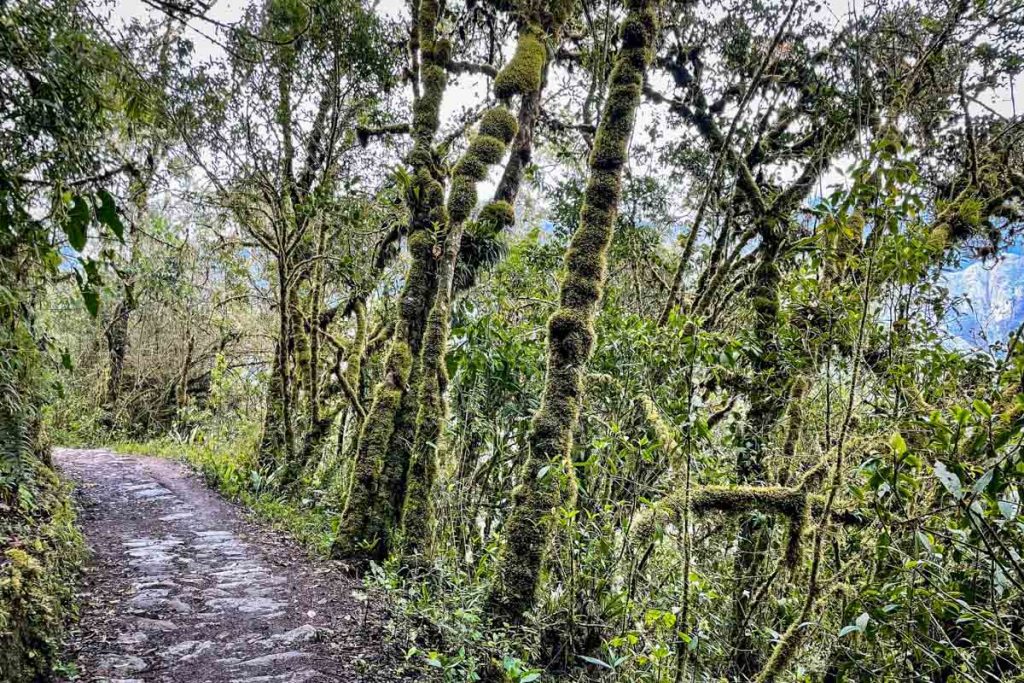
Keep these things in mind as you’re planning your Inca Trail trek to Machu Picchu. There were many new regulations put in place in 2019 that are important to note.
How far in advance do I need to make a reservation for the Inca Trail trek?
Trail permits tend to sell out 4-5 months in advance for high season and can sell out pretty early even for shoulder season. A safe bet would be to make your reservation 6 months in advance, especially if you hope to make the trek during June – August.
Can I hike the Inca Trail without a tour?
Trekking the Inca Trail without a guide has been prohibited since 2001. However, there are alternative ways to get to Machu Picchu that don’t involve a guide. If you are staying in Cusco, you can take the train in for a day trip. A closer alternative would be to stay the night in Aguas Calientes and take a bus up to the ruins.
We’ve outlined all the ways in our article on how to get to Machu Picchu.
How much does the Inca Trail cost?
A typical Inca Trail trekking tour will cost anywhere from about $600 – $1000 per person. As is with most tours, you get what you pay for.
If you are on a tight budget, plan to carry your own pack, and don’t mind roughing it a bit, you can aim for the lower end. If you prefer to have more comfortable accommodations (think plush blow up mattresses) and gourmet meals, you can spend a lot more.
Why is the Inca Trail so expensive?
Some tours are more expensive because they treat their staff better. Offering fair wages, better food and less strenuous working conditions to porters is going to cost more.
In our opinion, we are willing to pay a bit more to know we are supporting a company with responsible business practices.
The more expensive tours will also offer trekkers a better experience, more comfortable accommodations, better food and high quality equipment. Quite simply, you get what you pay for on the Inca Trail.
How difficult is the Inca Trail hike to Machu Picchu?
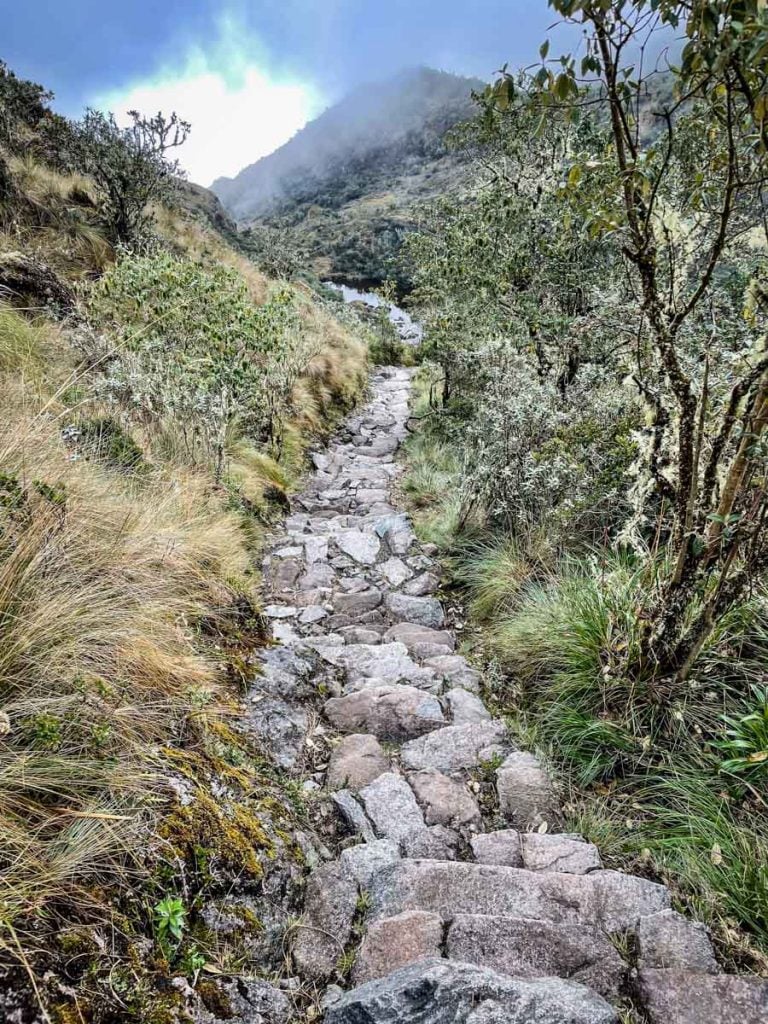
The hike is about 45 km (nearly 30 miles!), involving 5-10 hours of hiking rough mountainous terrain over 4 days at high altitude. While the trail is actually quite flat at times and a good portion of the hike is downhill, make no mistake, this is a difficult hike.
It is recommended to be well prepared and healthy by practicing regular exercise before your trek. You should also spend 2-3 days in Cusco prior to your trek (more if you have the time) to acclimate your body to the altitude.
This gives you a great opportunity to explore all the fun things to do in Cusco.
Do I need altitude sickness medication for the Inca Trail hike?
As long as you’ve given your body time to acclimate in Cusco, you should not have the need for any altitude sickness medication while on your trek. The guides will provide you with cocoa tea and cocoa leaves to chew (a very effective natural remedy) if you are feeling any effects while on the trail.
However, if you would feel more comfortable having medication with you, it’s your choice.
What if I have dietary restrictions, will my tour be able to accommodate?
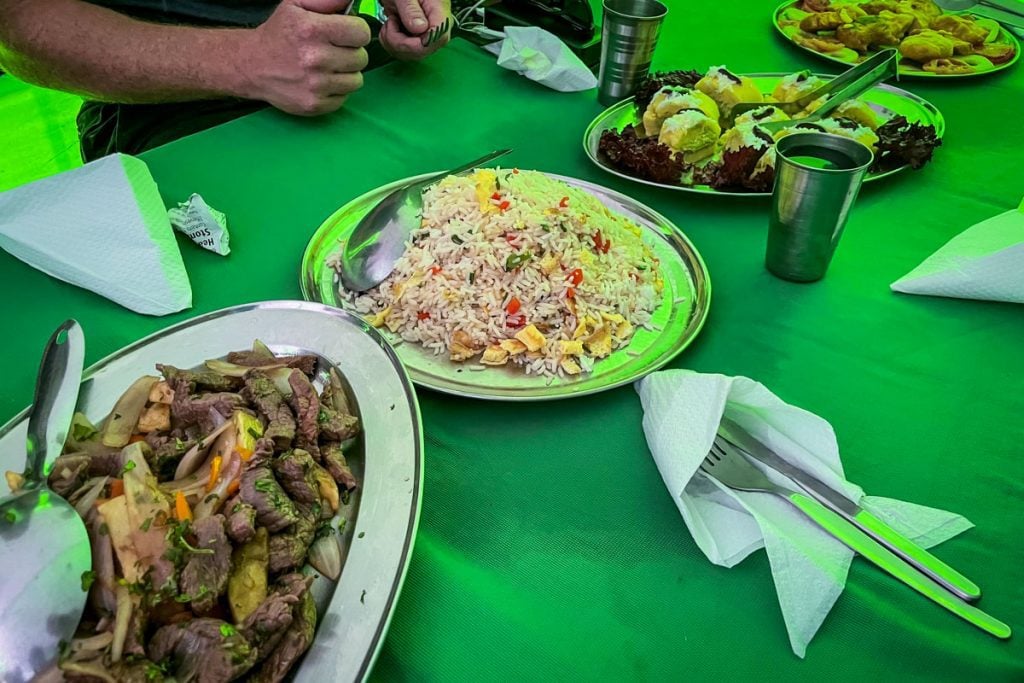
If you book your Inca Trail trek with Alpaca Expeditions, you are given the option for specific dietary requirements and they did a great job fulfilling those on my trek.
Most other tour companies will offer a vegetarian option and will possibly have some gluten-free and dairy-free substitutes, but will not cater to a major life-threatening allergy. However, most meals are served buffet style, so you can pick and choose what you prefer.
Do you need hiking poles for the Inca Trail hike?
While not required, we think it is absolutely worth it to have hiking poles on the Inca Trail to Machu Picchu trek. That being said, in an effort to keep the trail intact, you are required by law to have rubber stoppers on the ends of your poles.
If you book using our code TWS with Alpaca Expeditions, they will include trekking poles for FREE with your trek. These are regulation hiking poles with rubber stoppers, and the great news is you won’t have to travel all the way to Peru with them.
If you bring your own poles, you can purchase these rubber stoppers at many shops in Cusco. You can also rent poles in Cusco if you don’t have your own for about $10 for the 4-day trek.
What are the sleeping arrangements like?
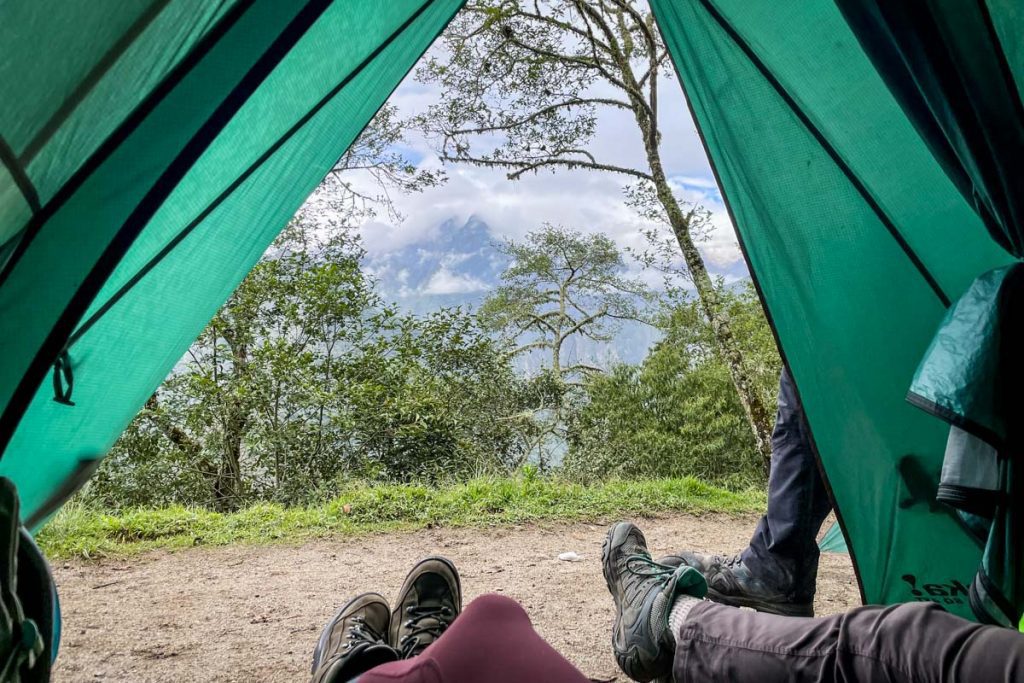
With Alpaca Expeditions, tents are based on 2 person occupancy. If you are traveling solo, you will be placed with another trekker of the same gender, or have the option to pay an extra fee for a single tent.
The tents are set up for you, including sleeping mats, and you’ll duffles will be in your tent when you arrive at the camp. They are pretty basic, but there is plenty of space for 2 people plus your duffles, boots and poles.
Are there toilets on the Inca Trail?
Surprisingly, yes! Well sort of. Let me explain…
On the first day of your trek, there are actually public bathrooms available at regular intervals along the way. These can be pretty rustic, but at least you’ll be able to flush!
There are a few more instances on the second and third days where you’ll have the chance to stop at a bathroom, but for the most part, you may be using the “Inca toilet” aka going in the woods.
At night where you set up camp, Alpaca Expeditions provides private portable toilet tents that are just for the use of your group.
Be sure to bring your own toilet paper as the public restrooms usually don’t provide it, and pack out your waste if you are going in the woods.
Are there showers on the Inca Trail?
In short, no. There are no hot showers on the Inca Trail. The campsite you stay in on the 3rd and final night does have showers, but they are freezing cold.
Instead you will be provided with a small bin of warm water and soap at your tent each night for washing up. You can use this to wash yourself in whatever way you choose, however, I found that wipes and deodorant went a long way on my trek.
Is there cell service on the Inca Trail?
There is spotty cell reception all throughout the trail, but it shouldn’t be counted on. There are lots of areas where you’ll lose service completely. Even at Machu Picchu the cell service is spotty at best.
Alpaca Expeditions sends their guides on the trail with satellite phones in case of emergencies.
For personal use, we recommend taking this time to unplug and disconnect. Let your work colleagues and loved ones know you will reconnect with them once you’ve returned to Cusco after 4 days.
Alternative hikes
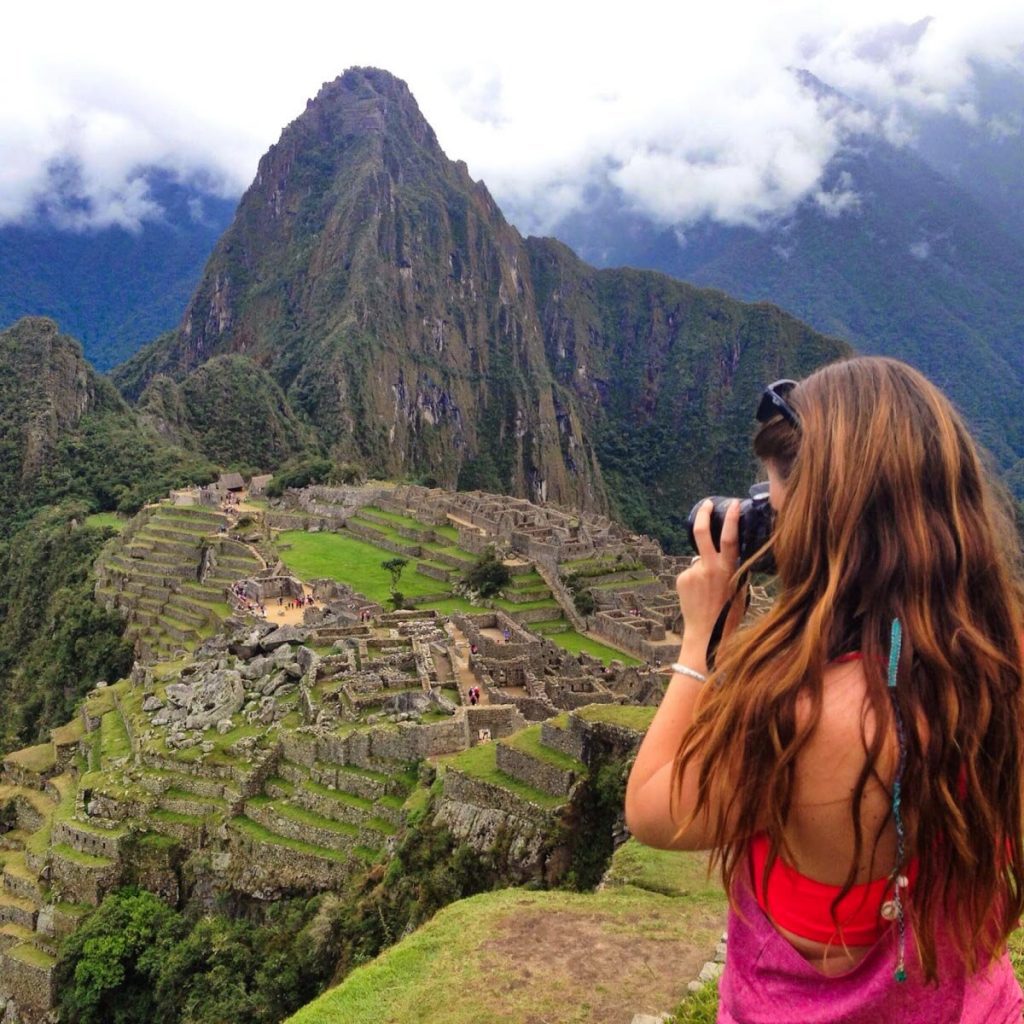
The popularity of the Inca Trail to Machu Picchu hike has led the Peruvian government to crack down on tourism. They aim to limit the damage to the trail by limiting the number of people allowed on the trail to 500 per day (which includes nearly 300 porters).
This makes it hard to snag a spot, especially during the peak tourism season from June – August, unless you’re planning your trip months in advance.
The good news is, the Inca were masters at building trails all throughout the Andes. If you’re heading to Peru and find yourself without an Inca Trail permit, there are some excellent alternative hikes you can do.
One-Day Inca Trail Trek
- Distance: 10 km
- Total Trekking Time: 1 day
- Difficulty Level: Moderate
- Peak Altitude: 2,680 meters
For those who want to experience the magic of the Inca Trail to Machu Picchu but are short on time, this shortened one-day trek is ideal. The trek starts from KM 104 on the Machu Picchu train route and follows the last steps of the full Inca Trail. You’ll hike to the Inca site known as Wiñay Wayna, then continue on to enter Machu Picchu through the Sun Gate late in the day.
Most tours include an overnight in Aguas Calientes, and your official tour of Machu Picchu the following morning.
Salkantay Trek
- Distance: 74 km
- Total Trekking Time: 5 days
- Difficulty Level: Moderate – Difficult
- Peak Altitude: 4,600 meters
Known for its incredible scenery, the Salkantay Trek to Machu Picchu is probably the most popular alternative to the Inca Trail. Mount Salkantay was another one of the holy peaks of the Inca religious pantheon.
Trek through Mollepata Valley, over the Apacheta Pass and through a subtropical cloud forest as you make your way to the recently rediscovered ruins of Llactapata. From there you can get a unique glimpse of Machu Picchu from across the valley. On your final day, you will make your way to Machu Picchu to explore the famous site.
The Lares Route
- Distance: 34 km
- Total Trekking Time: 4 days
- Difficulty Level: Moderate – Difficult
- Peak Altitude: 4,780 meters
Adjacent to the Sacred Valley is a beautiful valley, untouched by most tourists making their way to Machu Picchu. Daily life for the inhabitants of the Lares Valley is a traditional way of life that has been led for centuries.
This trek starts in the small village of Lares, which is also home to a famous hot spring. You’ll make your way up Mount Veronica, passing through small villages and around several high-altitude lakes. Your final stop is the historic ruins of Ollantaytambo. From there you’ll hop a 90 minute train to Machu Picchu.
Other epic hikes to add to your bucket list
If you’re reading this article, I imagine you’re a hiking enthusiast.
- Tongariro Crossing, New Zealand: Widely considered to be the best day hike in New Zealand, this is a can’t-miss if you’re visiting the North Island.
- Routeburn Track, New Zealand: If you’re traveling in New Zealand, you’ll want to add this hike to your list as well. This multi-day trek on the South Island is one of the best hikes in the country.
- Fimmvorduhals Hike, Iceland: This is one of our very favorite day hikes ever, and if you like the Tongariro Crossing, this should also be on your list!
- Old Man of Storr, Scotland: This hike on the Isle of Skye brings you up close to some otherworldly rock formations.
- Kumano Kodo, Japan: This multi-day pilgrimage trek in Japan is a perfect blend of adventure, nature and culture.
- Volcan Acatenango, Guatemala: This overnight hike just outside Antigua allows you front seat views to watch the neighboring Volcan Fuego erupt all night long.
- Ijen Crater, Indonesia: This classic sunrise hike in East Java ends with epic views over a neon blue crater lake.
- Everest Base Camp: If you’re looking for a hike you’ll be telling your grandkids about, this is it! Stay at tea houses along the way and make lifelong friends.
Are you planning a trip to Peru?
We have lots of resources on travel in Peru and destinations throughout the country. Check out our Complete Peru Travel Guide for all the answers to your most burning questions, or read some of our favorite articles below.
- How to Get from Lima to Cusco
- Exciting Things to Do in Cusco
- Best Time to Visit Peru: When to Go & When to Avoid
- Rainbow Mountain Peru: How to Get There & What to Expect
Save this article on Pinterest for later!
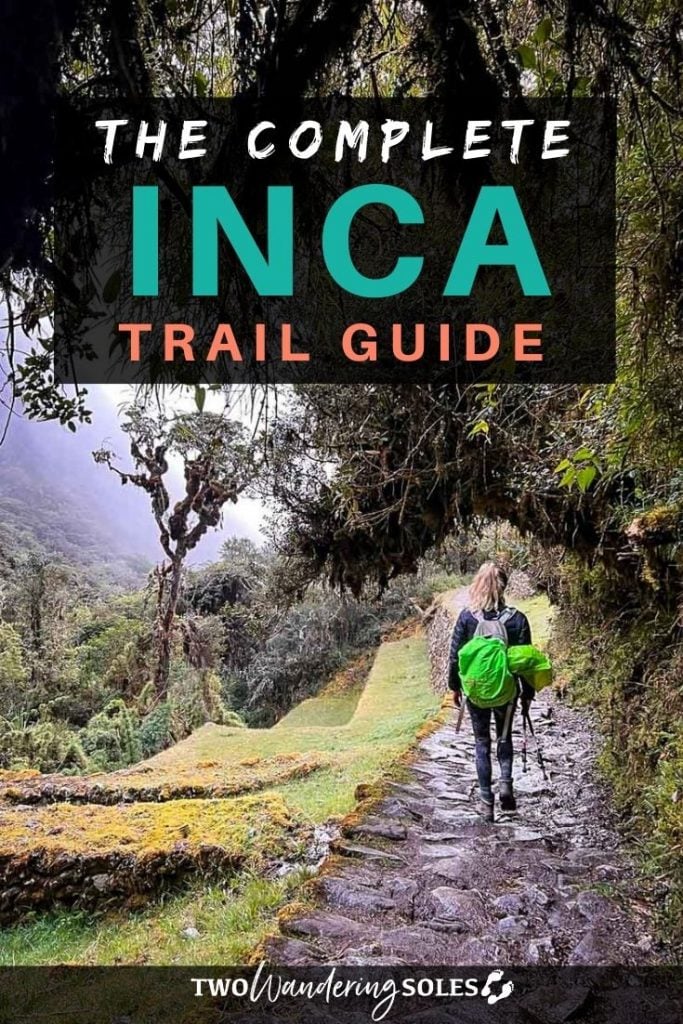
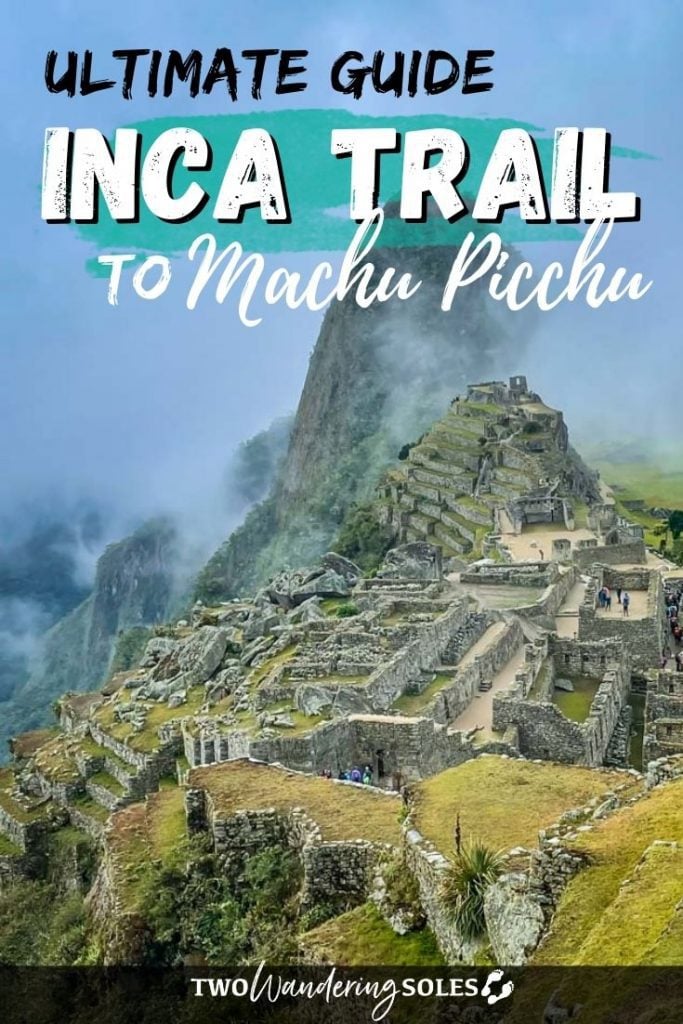
We want to hear from you!
Have you ever been to Machu Picchu before? What was your experience like? Are you planning to hike the Inca Trail tp Machu Picchu and still have questions? Leave your comment below and we’ll do our best to get back to you!

Very good this blog has very good information I thought to do the Inca Trail, I was thinking about doing in September but the availability is very limited recommended the alternative route salkantay trek and I am looking forward to the operator agency that is lets go inca trail me They gave very good recommendations
That’s great Amber. Sounds like you have some awesome travel plans soon. Safe travels.
Very good experience in Machu Picchu Katie and Ben and thank you very much for sharing it with us. It is important to remind everyone who is interested in doing this trek , that there are two basic tours, 4 days (classic) and 2 days (short). The classic one has to book at least 6 months in advance and the short one 2 months in advance. Of course there are more alternatives to get to Machu Picchu as the beautiful Salkantay Trek that I hope you can do soon.
Greetings from Peru!
Elvis
Thanks for the info!
This sounds like an amazing experience! We are planning a trip to South America in just over a years time but are torn between Buenos Aires and Lima. I would love to visit Machu Picchu and hike the Inca Trail but we would have a 4 and 5 year old along with us. Do you think it would be too difficult for them? We are a very active family and hike/camp often but only in the states.
Thank you very much for the excellent information of the blog and has very good shots, I thought to make the Inca road in July but there is no availability, the good thing is that there are very good alternatives to get to the wonder of Peru are the salkantay trek I found a good price
regards
Hey there, glad to hear you’re finding more things to do in Peru. We would love to explore around there again!
My partner and I just completed our vacation in Machu Picchu, and highly recommend this company http://inkatrailexplorer.com/machu-picchu-packages/machu-picchu-travel-full-day-tour/ . We opted for the two day tour, beginning with a day in the Sacred Valley, and a day in Machu Picchu (via train). Months before our trip, the company was very helpful with suggestions. The tour covered us from our landing at the Cusco airport to taking us back to the airport and everything in between. Our guide for the tour, Juan de Dios, was exceptionally knowledgeable and informative – – he’s also a great guy and very personable with a great sense of humor and perfect English speaking skills. We were very pleased with the tour and the accommodations in Cusco that were part of the tour. The price of the tour was very reasonable considering everything that was included. I also want to mention that we are a gay couple, and that everyone associated with Inka Trail Explorer treated us very graciously and made us feel welcome.
Great to hear James, thanks for the additional tips.
There are many alternative routes to Machu Picchu such as the Salkantay trail, Inca Jungle, rainbow mountain, Choquequirao trek, Lares trek, by train and also by bus.
Thank you so much for your additional travel tips in Peru other than Machu Picchu and the Inca Trail.
Another option to travel to Machu Picchu, it is by the Salkantay route. Good landscapes and good experiences.
http://www.salkantaytrek.com.pe Salkantay Trek is one of the best routes to Machu Picchu.
Hey Salkantay Treks, Thanks for the comment about your company.
Hi Katie!
Loved reading your post! My boyfriend and I just planned our trip to Peru! We want to do a 1 day tour to Machu PIcchu (not the hike) since we won’t have enough time. Do you recommend any specific site we should use to get a 1 day tour? Thanks!
Hey Tessa! I’m excited you’re planning on going to Machu Picchu. I can’t think of any one day tour companies off the top of my head, but I when you are searching for a tour make sure to find one that pays its guides well and has good reviews! Happy planning!
Hi Katie!
First, I love reading your blog! My boyfriend and I booked our Peru trip for two weeks in September. I am so excited to visit this beautiful country! Second, I have a couple questions regarding Machu Picchu:
1. We actually didn’t book with a touring company to hike Machu Picchu with. Do you suggest doing so? We purchased the Machu Picchu + Huayna Picchu ticket and planned on (hopefully) spending just one day at Machu Picchu if possible. Are the ruins supposed to be a multiple day hike?
2. Sort of goes in ties with the first question, how long did it take for you to reach the peak of Machu Picchu? We are afraid that since we aren’t going through a tour company we will end up being stranded if it takes too long to reach the top and to descend.
Please, all the feedback and tips would be very much appreciated! Thank you!
Kayli
Hi Kayli, you have a great trip awaiting you! Since the early 2000’s tourists have not been able to hike to Machu Picchu without a guide. This means that if you want to incorporate a hike with your visit to MP, you MUST go with a tour company. There are different types of hikes – from several days to very short – and from the classic Inca Trek (4 days/3nights) to lesser known ones. Easy ones, hard ones, and even hikes that involve mountain biking too!
Alternatively, you can just buy the entrance to MP in advance and wander around the ruins by yourself. It sounds like this is the route you’re taking? If you do this, you cannot hike there, but instead will take a shuttle bus from Aguas Calientes (the closest town).
If you really have your heart set on hiking (I would strongly recommend it!), I would suggest reaching out to a company and telling them you already have your entrance permit. Perhaps then they could work out some kind of discount since you don’t have to get it through them. Typically though, people get all of it through the company, so the package price you’ll see online includes your entrance ticket as well as all food, tent/equipment, guide, porters, transportation.
I hope this helps!
Yes, Hiking in the mountains is an amazing adventure activity and peru is the best destination. But are you planning same experience in Nepal, of course we Nepal Footprint Holiday offers you with the best experience trekking and hiking in Nepal Himalayas. Since 2001 we are operating the trekking in Nepal and its ongoing. Go through our website https://www.nepalfootprintholiday.com for details.
I can see many incredible things that the world hide for us here. but, I would like to recommend you to visit Peru and fine amazing places as worldwide known.
choose for a local company who has a responsible tourism in all Peru. http://www.sparrowexplorer.com/
Thanks Mr. Sparrow for your tips.
Hey, Katie!
What time of year did you visit?
Hi Anna. We were there in the spring time around mid-April. We would totally recommend that time of year to go!
Im leaving for Peru in a month and your blog has been fantastic to get ideas! what is the company you did this trek with ?
Hey Amanda, thanks for the nice comment! We did our Inca Trail trek through Peru Treks.
http://www.perutreks.com/
We had a great experience and felt like the porters were treated well (better than some other groups we saw). Best of luck planning your trip!
Hey you two – this is Deena from Denver, Colorado. I am so impressed and excited for your world adventures. I started my worldly travels as a solo woman back when it was unheard of and everyone was afraid for me taking off for a year to waunder the globe in my 30s and 40s. I am now 64 and after retiring recently I’m actively looking to go to all the places I haven’t been yet – like Galagapos and Machu Picchu. Your information is wonderful and helpful in getting me back in the saddle. Due to limitations now, I need to either go with a tour or find less rigorous independent travel. Do I need to book M.P. before I leave home? Or, can I arrive in Quito and book something locally in 1-2 days? I like the idea of paying the locals and not the tour companies which I have avoided all my life, but may need to embrace now. Good travels to you.
Hi there Deena, We’re so happy to connect with a like-minded soul! We are always so impressed talking to women who traveled solo a few decades ago, because that would have been such an unheard of thing to do. Good for you to defy what people think is possible!
I would certainly recommend booking Machu Picchu before you leave on your trip. Due to increasing amounts of tourists each year, they are limiting the number of permits for visitors each day. Definitely do a bit of research, because some companies take advantage of the locals. We liked Peru Treks, because although they were a bit more expensive, they focused on treating their porters well. You can even look into some shorter treks if you don’t want to do the full 4-day hike.
I hope this is helpful. Thanks for the kind words – they really mean a lot 🙂
Travel on!
Hey Katie! What was the one day hike you did your first time around called?!
Hey Morgan, It was about 5 years ago, so I had to do a little digging, but I think it was this one (or something similar):
http://www.sastravelperu.com/english/program/344/short-inca-trail-trek-to-machu-picchu-2day1night-group-service
Let me know if you have any more questions. Happy planning!
this site is such an inspiration for me and my husband. We have recently planned a trip to Peru in March for our first inca trail with Alpaca Expeditions Tours
Thank you so much! That’s such a compliment! We hope you have such an amazing time!